-
Leica Store wrote a new post, Leica D-Lux 6 Review: A solid improvement over the D-Lux 5 12 years ago
The new Leica D-Lux 6, replacement to the popular D-Lux 5, has started to ship in the United States, and I have been playing with it for a few days (the above image of the water tower was taken with the D-Lux 6, 24mm, 1/250th at f/4, ISO80). As a D-Lux 5 owner myself, I was especially curious how the camera differed from what I knew well. Leica’s D-Lux line has always been marketed as the “enthusiast’s compact camera;” the models feature RAW file capture, full manual control, and slightly larger sensors for optimal low-light shooting.
Some of the key new features of the D-Lux 6:- Newly designed lens with an aperture range of f/1.4-2.3 from an equivalent focal range of 24-90mm.
- CMOS sensor (versus a CCD in the D-Lux 5) for better high ISO performance
- High resolution, 920,000 pixel 3-inch LCD screen (compared to 460,000 pixels on D-lux 5).
- Aperture ring around the lens for quick, intuitive adjustment
- Stereo microphone with full 1080p video recording
- 3-stop neutral density filter built in (for shooting in bright light at f/1.4)
- Built in spirit level to assure perfect composition
- Faster burst shooting, up to 11 frames per second
- Improved build quality and streamlined design
- Improved operational speed and focusing
In hand, the improved build quality of the D-Lux 6 is immediately evident. The camera feels sturdier; all of the switches and dials are stiffer. The top mode dial, which I would frequently change accidentally on the D-Lux 5, is much tighter. The shutter button has also been redesigned to be easier to use and has a more positive “half-press” position. The various markings on the top of the camera have been redesigned to give the top plate a cleaner design that is easier to read. Also on the top plate you can see the new stereo microphone for better sound recording while shooting video (which is now full 1080p).
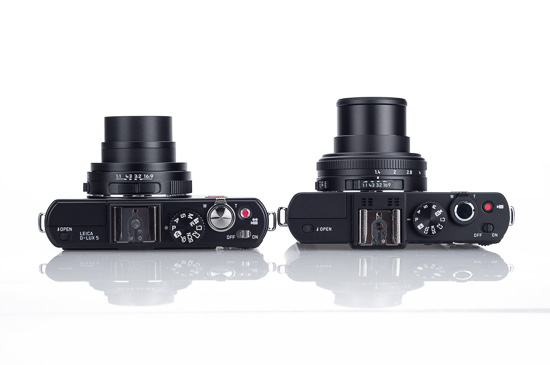
From the top, the differences are more apparent. The D-Lux 6's stereo microphone is visible in front of the hot shoe. The lens on the D-Lux 6 extends slightly further.
Looking at the back of the camera, the most obvious new feature is the gorgeous, high resolution LCD screen which is double the resolution of the D-Lux 5. This makes shooting, focusing, and reviewing images an absolute pleasure. Along the top edge you can see the new “ND/Focus” switch, which activates the camera’s built in 3 stop neutral density filter (to allow you to use the lens wide open at f/1.4 in bright light) and also controls the manual focusing. The rear buttons have been redesigned to be easier to press, even for those with large hands.
Turn the camera over and from the front, they appear almost identical, other than the D-Lux 6 being slightly taller. Surrounding the lens of the D-Lux 6 is the new aperture ring. Familiar to anyone coming from a larger SLR or rangefinder camera, the aperture ring allows for quick and definitive aperture settings in either aperture priority or full manual mode. Take my advice and leave it at f/1.4, you won’t regret it! It is also important to mention that the aperture ring will not alter the camera's aperture settings in Program Mode, Shutter Priority Mode, or Auto Mode. It requires the camera to be in either Manual or Aperture Priority mode.
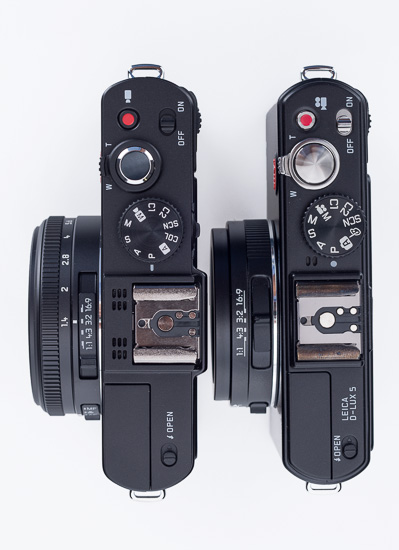
Seen from the top, the markings on top of the D-Lux 6 have been simplified and the areas surrounding the shutter button and power switch have been “blacked out” for a cleaner look.
In use, the D-Lux 6 is faster all around. Power the D-Lux 5 and the D-Lux 6 on at the same time, and the D-Lux 6 is ready to shoot when the 5 is still powering up. Auto focus is also faster, and I found it to be more reliable, even when using the camera at f/1.4. Shot-to-shot times are dramatically improved with the D-Lux 6. I had no sluggish performance or lag times when shooting RAW+JPEG unlike the D-Lux 5, where the camera slows down after two images. If you set the camera to self-timer mode, the D-Lux 6 retains this setting until you turn the camera off, a welcome change, as the D-Lux 5 would reset back to standard shooting after every shot!
The graphical menu interface has also been updated, with a new exposure scale for easier manual settings, and a spirit level that confirms when your shot is perfectly level. The menus are sharper and easier to read, thanks partially to the newer high resolution screen, and a redesign of the type-face. Many settings are more logically named. The quick-menu follows this philosophy as well, and accessing key settings is easier than ever. Even though I am quite familiar with the D-Lux 5’s menu system, I found the D-Lux 6 much more intuitive and the various options easier to understand thanks to some renaming and streamlining.
About the only downside from all these improvements is a slight reduction in the D-Lux 6's battery life when compared to the D-Lux 5. A full day of use, without turning the camera off at all, yielded about 300 shots before the battery was completely dead. One battery-saving tip: turn the “Quick AF” setting to “off”. Quick AF uses' the cameras movement-detection system (normally used to stabilize the camera and reduce shake for longer exposures) to sense when the camera is steady, which is usually as you are composing your image, and will focus the lens on the subject before you actually press the shutter. While this makes for somewhat faster focusing, it will dramatically reduce battery life. I found that if I walked around with the camera turned on, it would occasionally activate Quick AF when the camera was resting around my neck. Turning off Quick AF would certainly have extended the battery to 350 shots and beyond. I would recommend getting a second battery if you plan on traveling with the camera, just to be safe.
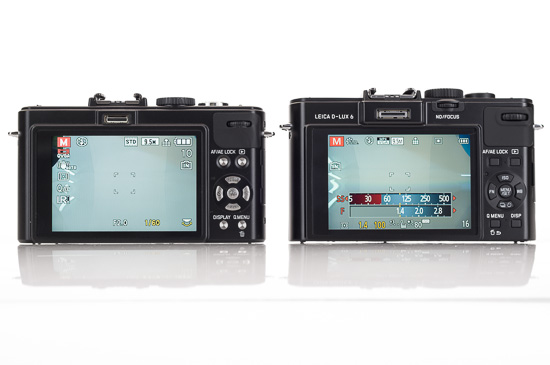
The new exposure scale for manual shooting on the D-Lux 6 makes setting up aperture and shutter speed much easier and quicker.
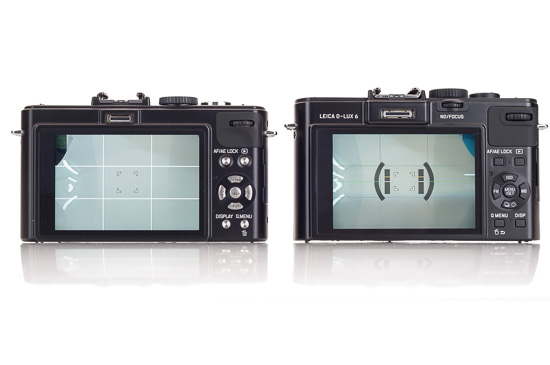
The spirit level function of the D-Lux 6 makes perfect composition easier than the simple grid function on the D-Lux 5.
Of course the real highlight of the D-Lux 6 is its low-light performance. The lens’ maximum aperture has been improved through the range, from f/2.0-3.3 on the D-Lux 5 to f/1.4-2.3 on the D-Lux 6. The change from a CCD to CMOS sensor also gives the camera better high ISO performance.All in all, I know that personally I will be acquiring a D-Lux 6 to use as my daily compact camera. The D-Lux 5 was no slouch, but the improvements Leica has introduced make the upgrade an easy decision. Faster auto focus and operation, a gorgeous LCD screen, improved low light performance, better build quality, and full 1080p HD video are all I could have asked for and more. Sign me up!
-
Leica Store wrote a new post, Photos from the Leica S-Studio in New York City 13 years ago
This week, Photo Plus Expo is going on at the Javits Center, and in addition to their booth at the show, Leica also has a dedicated S-Studio to demonstrate the latest addition to the Leica product line, the […]
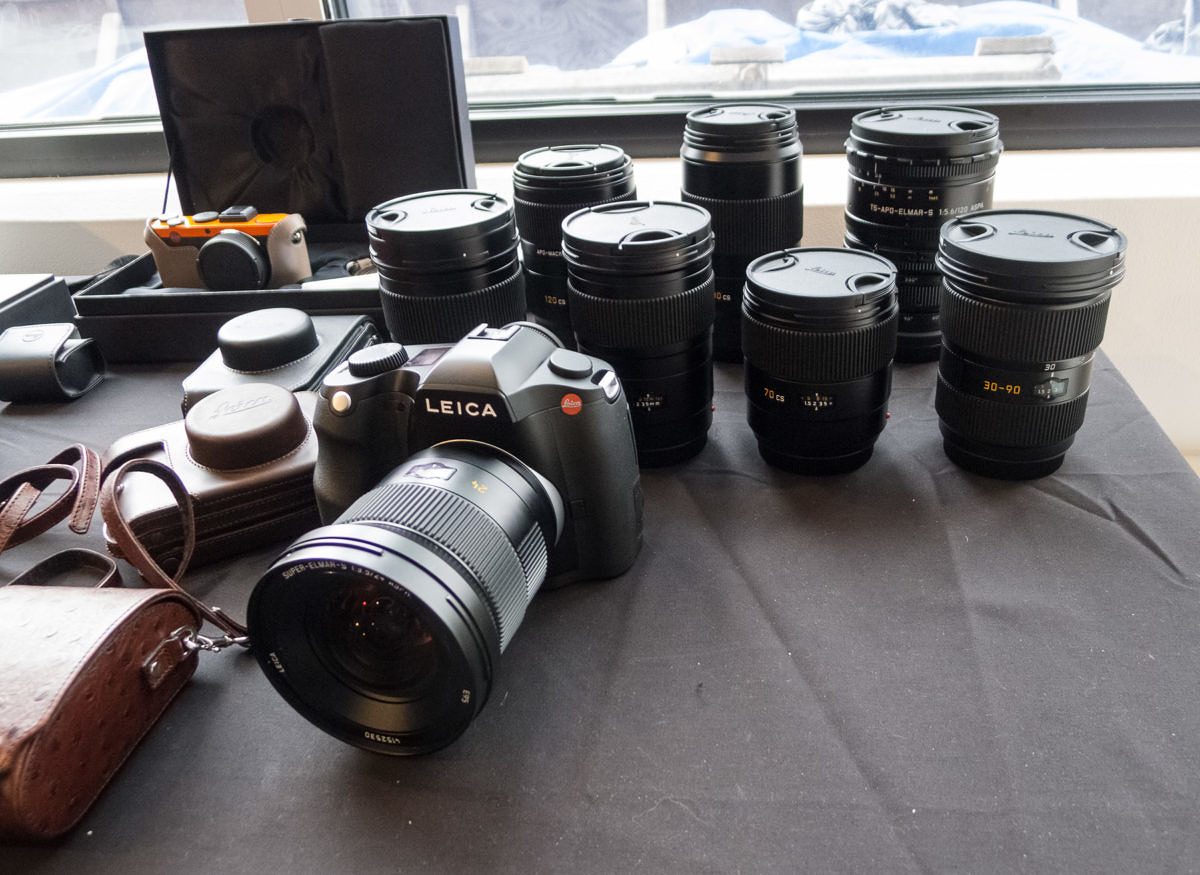
-
Leica Store wrote a new post, Leica Studio in NYC for Photo Plus Expo 13 years ago
If you are going to be in New York City for Photo Plus Expo this year, you can see Leica's full range of products at their booth at the Javits Center, and visit the S Studio for all of the new S-System […]
-
Leica Store wrote a new post, VIP Reception | NYC hosted by Dale Photo Digital 13 years ago
Join David and Josh from Dale Photo & Digital for an intimate gathering at the Andaz Wall Street Hotel in lower Manhattan for hors d'oeuvres, drinks, and great discussion about Leica cameras and […]
-
Leica Store wrote a new post, The Leica M-E Compared 13 years ago
Today, we received our first shipment of the new Leica M-E. When Leica announced the M-E, there were a lot of questions about how it fit into Leica’s lineup and what was different when compared to the M9 and M9-P. Now that the camera is here in our store, we put it on our shooting table to compare it against Leica’s current lineup of digital M cameras.
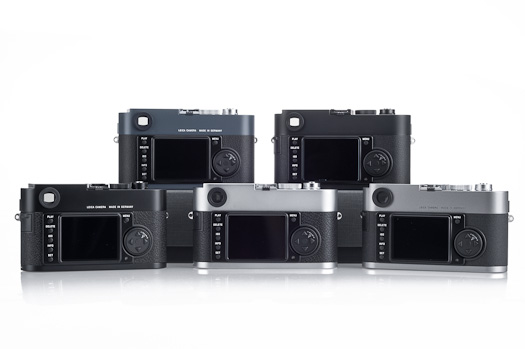
Top row: Leica M-E, M Monochrom. Bottom row: M9 Black Paint, M9-P Silver Chrome, and M9 Steel Grey. Notice the white Leica Camera Made in Germany writing on the back of the M-E, similar to the M9 Black Paint.
Here are the highlights:
- The finish on the Leica M-E differs greatly from the steel grey M9. It has slight blue color to it and looks very classy with either a silver or black lens.
- The leatherette covering on the M-E is identical to the M Monochrom. It’s softer to the touch than the M9 or M9-P. The pattern on the covering is slightly tighter than the M9-P’s leatherette.
- The accents are silver chrome – the hot shoe, shutter button and surrounding material, shutter speed dial, and release lever on the bottom plate. This allows the camera to coordinate well with silver chrome lenses. Also, I think a silver chrome Thumbs Up would look great on the M-E.
- The M-E does not have a model logo engraved on the front like the original M9; it is similar to the M9-P and M Monochrom in that regard.
- The two major physical differences from all of Leica’s other digital M cameras to date: the camera does not have a frame line preview lever on the front or a USB port on the side.
- The “Leica Camera Made in Germany” engraving on the back is in white, similar to a black M9.
- The hot shoe is engraved with “Leica M-E” in addition to the serial number (like the M9-P and M Monochrom).
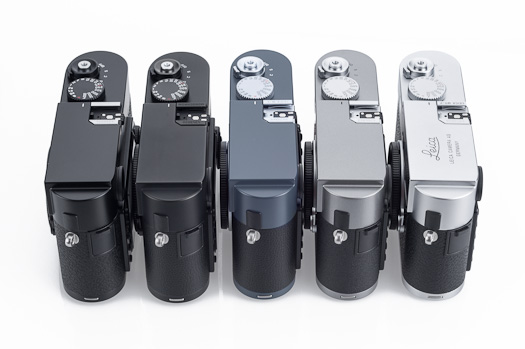
From left to right: Leica M9 Black Paint, M Monochrom, M-E, M9 Steel Grey, and M9-P Silver Chrome. Here you can see the blue tint to the M-E's finish, and the lack of a USB port.
Overall, I am very pleased with how the camera looks. It was difficult for me to assess the exact color of the finish using only Leica’s official press images as reference, but seeing it in person; I can see how it differs quite a lot from the steel grey M9. The new Leica M-E combines the well-loved, 18 megapixel CCD sensor of the M9/M9-P, but updates the camera’s look for 2012. The removal of the USB port and frame line selector allows Leica to offer the camera at a lower price point, and further improves the cameras ruggedness and reliability (less moving parts and switches equals more durability). The new finish, known as “anthracite grey” is unique and will match just about any accessory or lens you can mount on the camera. I can't wait to take this camera out shooting!
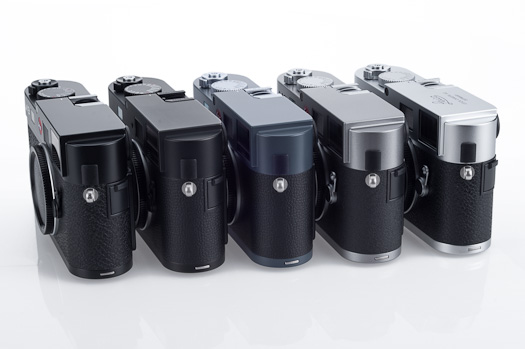
From left to right: Leica M9 Black Paint, M Monochrom, M-E, M9 Steel Grey, and M9-P Silver Chrome. The removal of the USB port really cleans up the M-E's design.
Dale Photo & Digital currently has the Leica M-E in stock, call 1-800-327-1776 for more information. -
Leica Store wrote a new post, Photokina 2012: Day 4 – Compact Cameras: Leica X2, D-Lux 6 and V-Lux 4 13 years ago
Leica is really firing on all cylinders this show. The new M is probably the biggest hit of the show. The S camera has some really solid updates and three new S lenses were introduced. But, these weren’t the only introductions from Leica. There is plenty of compact camera news, too. You, know, for when you don’t want to carry your full kit and just want something to take out to dinner with a group of friends.
Leica introduced the X2 back in May at their Das Wesentliche event in Berlin alongside the M Monochrom (see my full M Monochrom review ). The camera was a significant update to the X1 and has been extremely well received (see my full X2 review). Personally, I use it as my everyday camera. All my photos of various Leica staff members were shot with the X2. Unfortunately, it doesn’t focus as close as I’d like sometimes, so I used a D-Lux 5 for all my product close-ups.
Obviously, with the camera just introduced a few months ago, the X2 isn’t due for any major updates. Instead, the X2 is getting some special style treatment for Photokina. First up is the Paul Smith Edition X2. Limited to 1500 pieces and designed by British fashion designer Paul Smith, this X2 is quite boldly styled. With an orange top plate, lime green bottom plate and British racing green leather in between, the look isn’t for everyone, but it is unmistakable for sure. Combined with a handsome tan leather half case, I’m sure this limited edition, being sold only through Leica Stores and Boutiques, will go very quickly.
Also, only available from Leica Stores and Boutiques is the a la carte X2. Not limited to any quantities, the new X2 a la carte program lets would-be X2 owners customized a camera to their tastes. With ten different leather coverings ranging from trendy apple green to classic cognac, three metal finishes (silver, black and titanium), along with matching straps and half cases, there are literally thousands of combinations.
And, if a lemon yellow and black camera isn’t unique enough for your tastes, you can also get custom engraving in three different spots on the camera’s top plate.
Camera leather, straps and half cases don’t need to match, either. Perhaps it is the influence of the Paul Smith, but the idea of a totally mismatched combo actually seems pretty cool. I don’t actually see the a la carte program as just for collectors. I legitimately think it’s a great idea. As I played with a few different combinations, I looked over at my black X2, looking so…. Not as cool. So, if you’re willing to wait 4-6 weeks and fork over a few hundred dollars more, an a la carte might be for you.

Mixing up is allowed: Titanium finish camera with Capri blue leather, Apple green half case and Lemon yellow strap
While the X2 wasn’t new, Leica did show two new compact digital cameras, the D-Lux 6 and V-Lux 4. The D-Lux 6 got a hefty update from the extraordinarily popular D-Lux 5. Now, with an f/1.4-2.3 lens covering an equivalent range of 24-90mm, a new 10MP CMOS sensor with improved low light performance, the ability to shoot full 1080p HD video, and a high resolution 920K pixel 3” LCD, the D-Lux 6 should come as a welcome upgrade and a very capable all-rounder. The camera will also take the new 1.4MP EVF3 in its hot shoe and has an honest-to-goodness aperture ring on the lens. Priced at $799, the camera should be available starting in November.
The V-Lux 4 got some similar updates. Boasting an unbelievable 25-600mm equivalent lens with a constant aperture of f/2.8 throughout the entire range, a new low-noise 12MP CMOS sensor, a super high res 1.3MP built-in EVF and continuous shooting up to 12 fps, the V-Lux 4 can handle everything from the kids’ soccer game to shooting video at the holidays. The V-Lux 4 should also start shipping in November with a price of $899.

Leica V-Lux 4 with 25-600mm (equiv) f/2.8 lens with lens shade attached (no, it's not that big in real life)
Playing with both cameras at Photokina, I could immediately feel how quick, responsive and extremely simple they were to use. Even though I use an S2 as my main camera, with plenty of M shooting for more spontaneous outings, I still find a lot of use for the D-Lux and V-Lux cameras. At the show, both my D-Lux 5 and V-Lux 3 served me well. All the product shots, including the ones in this article, were shot with the D-Lux 5 and all the videos were taken with the V-Lux 3.
I often take the V-Lux to my daughter’s school activities like cheerleading where I am in the stands and she is on the football field. Here a 600mm lens and image stabilization really help. And, with the new fast f/2.8 lens on the V-Lux 4, I will certainly be upgrading. Night shooting just got that much easier. Likewise, with the D-Lux 6, maximum aperture is now bumped to f/1.4, really expanding the possibilities for this small, but mighty performer.
The Leica D-Lux 6 and V-Lux 4 are both available for pre-order at Leica Store Miami, either online or by calling 305-921-4433.
-
Leica Store wrote a new post, Leica V-Lux 3 Giveaway 13 years ago
-
Leica Store wrote a new post, Leica M-E Begins Shipping in the United States 13 years ago
Dale Photo & Digital is happy to announce that shipments of the new Leica M-E have begun in the United States! The cameras should begin arriving within the next few days. This is exciting news for those who […]
-
Leica Store wrote a new post, Photokina 2012 – Red Dot Forum Interview with Jesko von Oeynhausen 13 years ago
It is obvious that Leica has stolen the spotlight at Photokina 2012 with a flurry of new announcements. Possibly the most exciting of their new products is the Leica M, successor to the groundbreaking M9 announced in late 2009. David was right there for all of it, previewing the full product lineup and offering his perspective. He sat down with Leica M product manager Jesko von Oeynhausen to talk about the new Leica M:
The interview offers some unique insight into Leica's new naming conventions, the M's video features and some of Leica's new accessories for the M. For coverage about the Leica M at Photokina, check out Red Dot Forum for David's write-ups:
Photokina 2012: Day 1 – The Leica M
Photokina 2012: Day 3 – More Updates on the New Leica M
To be involved in the discussion, visit the Leica M section of our forums.
Leica Store Miami is currently accepting pre-orders for the new Leica M. Call 305-921-4433 to learn more.
-
Leica Store wrote a new post, Photokina 2012: Day 3 – More Updates on the New Leica M 13 years ago
Obviously, there has been a great deal of interest in the new Leica M. Many people that I talk to here in Cologne think that the M is the standout product of this Photokina. Essentially, it is everything that M9 users have been asking for. Offering faster operation, longer battery life, well-implemented live view with focus peaking, a high resolution scratch-resistant LCD, optional EVF and keeping the time-tested optical rangefinder, LED illuminated frame lines, expanded ISO range with lower noise, improved menu interface, built-in virtual horizon, SDXC support, 50% faster continuous shooting, bigger buffer, ability to use with PC sync cord (via grip), ability to power camera externally (via grip), weather sealing, and more. Leica also saw fit to offer users features they didn’t ask for like full HD video capability and GPS (also with grip). It’s quite an extensive punch list and I think that Leica should be commended on offering all these new features and improvements, all the while keeping the camera true to its heritage. The design is classic, yet modern and the ergonomics are just perfect. Leica engineers actually worked with Audi design specifically for styling and ergonomics.
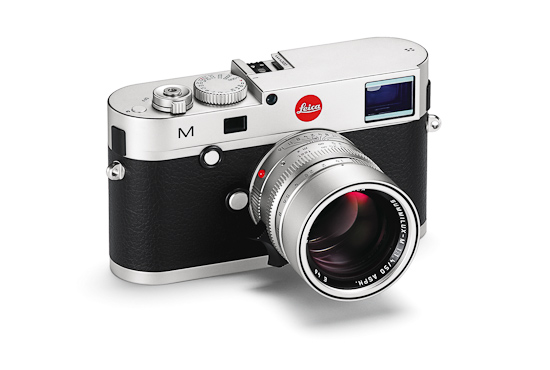
Oh, and R users finally will get a full-frame Leica digital solution as promised. If you follow the link, you’ll find the transcript of a Q&A session with director of product management Stefan Daniel from exactly two years ago. Leica knew then what they wanted to produce, even in the very early stages, and it shows from his answers and strong hints.I had the opportunity to sit down with Jesko von Oeynhausen on Thursday and discuss the M in more detail. I will be posting the full video when I return back to the US early next week, but did want to provide answers to questions that I’ve been receiving. We also discusses a few items off-camera, as we didn’t want to have a two hour video.
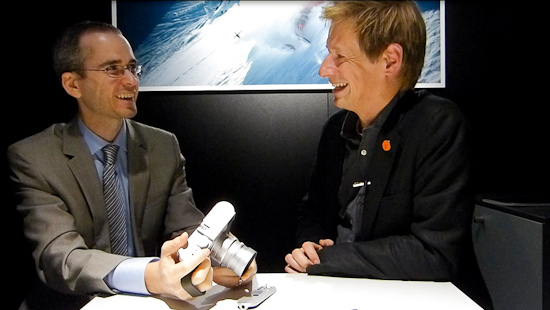
Does the new M use a different battery than the M9?Yes, the new M battery is actually two M9 battery cells combined in series, doubling the voltage. This allows live view functioning, but the sensor, Maestro ASIC processor and electronics are all more power efficient than the M9.Even with live view, users should at least the same amount of pictures, most likely more. Using the camera in classic rangefinder mode, without live view, you can expect more than three times more images.
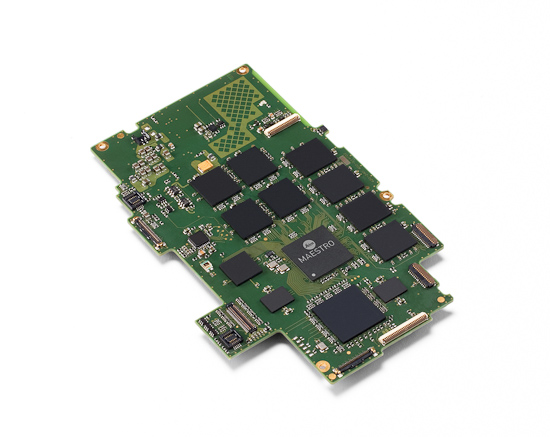
How much improvement will there be in noise and DR with the CMOS?It’s difficult to say now, before the firmware and sensor calibration is totally tweaked. I get the impression though, that the noise is at least a couple stops better than the M9 and that the M offers a little better DR as well. Again, we will have to judge when the files are made available.
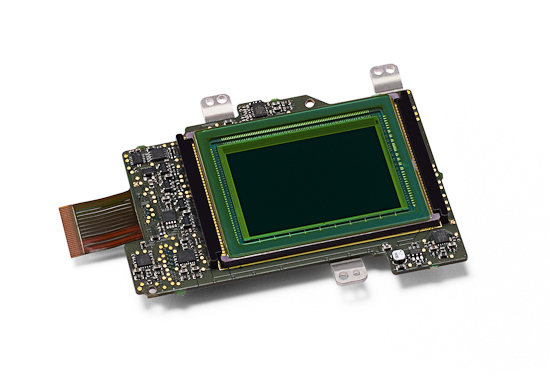
Will image quality or “look” be sacrificed with the move from CCD to CMOS?I seriously doubt this. Leica is, and has always been, committed to delivering that “Leica-look” and best possible image quality, even if it meant product delays. With all the digital Leicas I’ve used over the years, from the DMR to the S2 and M Monochrom, image quality has never been lacking. It’s like reviewing the latest crop of lenses that Leica has been releasing these last several years. There’s almost no point in quibbling as each one is just as stellar as the next. I’m starting to feel the same way about camera image quality. I just trust Leica to get it right. Sure, there was that whole IR debacle with the M8, but we can blame Kodak for that, and, with the filters the image quality was (and still is) excellent.
Are there ANY other differences with the M-E vs. M9 other than the lack of a frame line preview lever and USB port?
No. Those are the differences. And, the M-E comes in an anthracite finish with contrasting dials.
Is image review available in the EVF (like on the X2)?
Yes, you can review images in the EVF. In fact, when shooting through the EVF, this is the default behavior for image review. Keep in mind, though, that menus are only available on the rear LCD, not in the EVF regardless of mode.
How does the Gorilla glass compare in durability to the sapphire glass?
The Gorilla Glass is not quite as strong, but is probably 90% as much. It is also much less expensive, which keeps the cost of the camera down.
Why did Leica omit the frame line preview lever in the M?
The frame line preview lever was removed for cost savings. Very few were using the feature and it adds a complexity and associated cost to manufacture.
What is the buffer size shooting compressed and uncompressed DNG?
14 images in a burst using DNG compressed (3 fps), then another 20 or so at 1.5 fps.
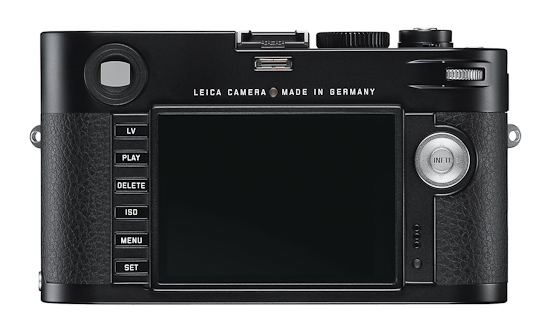
The new silver D-pad on the back of the camera is nice, but will Leica ever make it in black for black paint cameras?Probably not. This was just a style choice.
Will either of the hand grips be available in silver, or just black?
Only black will be offered.
How about the EVF? Will this be offered in silver?
No. Just black.
What is the longest exposure available in bulb?
60 seconds at base ISO. The main goal is image quality, and Leica is unwilling to sacrifice quality for longer exposure time. For most applications, 60 seconds should be plenty. In cases of astrophotography, exposure stacking would be a better option, anyway.
Are there any plans for an electronic shutter release for the grip?
No plans for this.
Can you shoot tethered and have access to live view thru Image Shuttle?
No LV to computer. Leica really wanted to do this, but it was not technically possible.
Any options for some kind of tethered video?
No. Same as above.
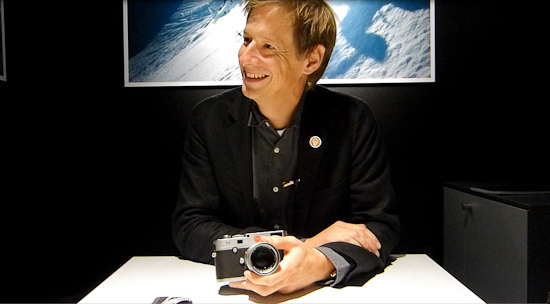
Can still images be shot while capturing video?Yes. The M was designed primarily as a still camera. So, you can always take a full resolution still image. The video will blank out and you will hear the shutter fire. After the shutter reopens (~1/2 sec), the video will resume.
What are the details on weather sealing? Is the lens mount sealed in any way?
The lens mount is not sealed. Usually lenses would have a gasket on mount, but no M lenses have this. The lenses themselves are built to such tight tolerances and have oil between the parts, which works to create a kind of sealing. The problem was never with the lenses. It has always been with bodies.
Why wasn’t automatic sensor cleaning included?
There was not enough room. Including a cleaning system would have made the camera thicker, which works against the design goal and the desire to maintain the same M dimensions.
Is there is still a manual lens selection in the menu for non-six bit coded M lenses?
Yes, same as on the M9.
Will you have to select the R lens you are using every time you mount the R adapter?
If you are just using one R lens, it will be remembered from the last time you used it. Obviously, if you are changing multiple R lenses, they will have to be selected each time.
What happens if I mount an M-Adapter-R on an M9?
It works, but because there is no rangefinder coupling or live view, focus will be purely trial and error.
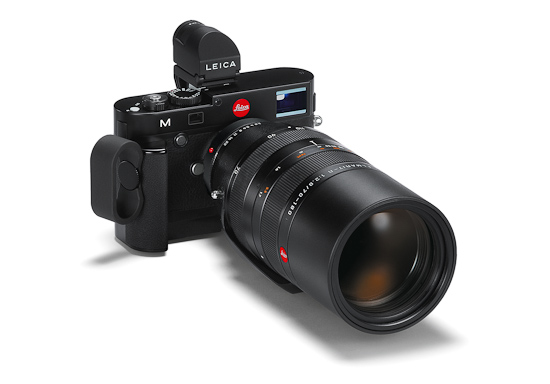
Are there any R lenses that cannot be used? Or that they don’t recommend?No. All lenses from 15mm to 800mm can be used without any problems.
What about R extension tubes and teleconverters?
Yes, these can be used as well without limitation.
Will video FPS settings be part of the user presets so you don’t always have to switch from 25 to 24fps, for example?
Yes. Video settings are stored in user presets.
Is the bottom plate on the M larger than the M9? How does overall body size/weight compare?
The Leica M does use a different bottom plate, but it less than 1mm wider from front to back. Overall, the camera is a few mm thinner than the M9 when measured from lens mount to the surface of LCD. In practice, there is no real distinguishable difference. The M does feel a little heavier, though. And it should, given that it has a double-sized battery, larger LCD, beefier electronics and more metal (rather than plastic) used.
Realistically, how will the M Monochrom compare to the M at similar ISO’s, given the M’s resolution increase and lower noise CMOS sensor
Noise will look different as there is no interpolation or color noise on the M Monochrom. On the flip side, the initial quality from the M at high ISO has been outstanding, but final comparisons haven’t been done.
If you haven't already, you can check out my full review on the M Monochrom here, and the ISO noise test I did between it and the M9 here. When I can get my hands on the Leica M, I will be publishing a similar test.
Stay tuned for the full video for even more information on the new M.
-
Leica Store wrote a new post, Photokina 2012: Day 2 – The Leica S (Part 2) 13 years ago
After a full rundown of the changes on the new Leica S camera which I covered in Part 1, I wanted to delve into the three new S lenses. Clearly, the announcement of the 30-90mm and the 24mm came as no surprise to anyone. Leica has been sharing the basic specs for some time now. The 120mm TS-APO-Elmar-S f/5.6 ASPH is a little different story, which is somewhat of a surprise. The lens might look familiar as it is the same excellent tilt-shift macro designed by Schneider Optics. Originally released in Mamiya mount for use on Phase One cameras, we found this lens worked well on the S2 with Leica’s M645 to S adapter. Really, the lens is most useful for table-top photography given its longer focal length. Still, having the lens in native S mount, covered under Leica warranty is not a bad thing at all. Just remember, the lens is manual focus and not weather sealed. This also wouldn’t be the first time that Leica has collaborated with Schneider on lenses. The legendary 15mm f/2.8 ASPH in R mount is a Schneider design.
The real story in my opinion are the 24 and 30-90, which really round out the S lens line-up nicely.
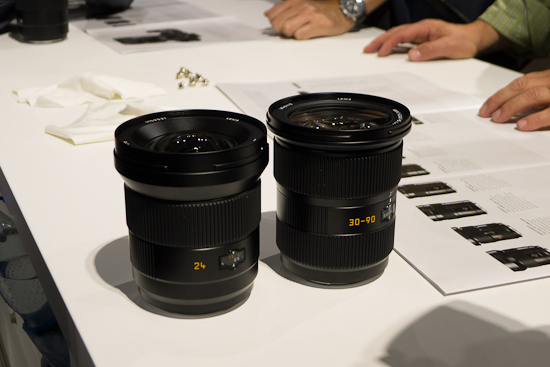
The 24mm Super-Elmar-S ASPH is extremely compact and offers a relatively fast aperture of f/3.5, just a half stop slower than f/2.8. It handles great and according to everyone I talked to in the Leica booth, is quite the performer. Peter Karbe, the head of optics for Leica, believes this lens sets a new benchmark for wide angle lenses in medium format. Distortion is extremely low and fully correctable in LR. Sharpness is outstanding. There is no shortage of exotic glass here – 12 elements in 10 groups, five of which have anomalous partial dispersion, three made from fluoride glass for CA control and three aspherical surfaces. And, by using a floating element design, performance from close focus to infinity is maintained. This lens is going to be phenomenal for interiors, architecture and landscape.MTF for 24mm
Since the S System came out, everyone has been lusting for the 30-90mm Vario-Elmar-S ASPH zoom. Well, after around two years in development, it’s here. And, it’s worth the wait.
Much smaller and lighter than I expected, the zoom is completely usable and portable. It is much, much smaller and lighter than the Hasselblad HCD 35-90 f/4.5-5.6, while sporting a wider zoom range and faster maximum aperture. Oh, yeah, and the Leica is also fully weather sealed just like the rest of the S lens line.
As with any zoom, there are some compromises versus fixed primes. I spoke with Dietmar Stuible, the optical designer of the new lens, who said that while it may appear simple to design a “normal” range zoom, the reality is that is actually extremely challenging to go from wide angle (24mm equiv) to short tele (90mm equiv) and maintain S-quality optical performance. So, the best compromise is to optimize for the middle range, where the lens will see the most use. Here, that is from 45 to 75mm.
Of, course, this doesn’t mean that the lens is bad in the wide angle range. Quite the contrary, actually. We are talking about resolving 70% contrast for 40lp at 30mm, its “weakest” point in the zoom range. Yeah, not too shabby. Looking at the MTF of the zoom versus the fixed 30mm Elmarit-S ASPH, the MTFs look strikingly similar. At 60mm, the MTF is almost perfect , resolving over 80% contrast wide open for 40lp. The bottom line is that this is a real S lens. Also featuring quite an exotic design, the Vario-Elmar uses 14 elements in 4 groups, of which 9 have anomalous partial dispersion, three fluoride glass elements and three aspherical surfaces.
When you hold the lens, you wouldn’t know that you’re moving all that glass around. Zooming, even on the pre-production model, was very smooth with just the right amount of drag on the zoom ring. Leica placed the zoom ring forward of the focus ring where it falls right in between your thumb and forefinger. The rear-placed focus ring is still easily workable by sliding your hand back a few inches. The decision was made to go this way for two reasons. First, this approach was much easier from a mechanical perspective. Secondly, users will spend more time zooming that using manual focus. After, all, the S is an autofocus system. The lens, while shorter in length than the fixed 35mm Summarit-S ASPH, does extend several inches when zooming all the way to 90mm. In spite of the exposed tube, it is still fully weather sealed.
For me, the real use of this lens isn’t to replace the fixed primes. A 70mm still offers a much faster aperture of f/2.5 in a lighter package. Where the zoom appeals to me is for tripod mounted landscape work. Not having to change a lens and being able to leave on my Schneider 4” filter set, while being able to change my perspective is huge. Less lens changes mean less times I have to dig into my backpack, less times shuffling filters, less exposure of the sensor to dust and moisture in the field and, ultimately, less break in the flow of shooting.
Both new lenses use 95mm filter size. According to Dietmar, the wider filter ring should allow the use of standard filter rings without any vignetting. I will be keen to try this with my Schneider 4” filter rig, which has a lot more depth than a polarizer.
In addition to the lenses, Leica also showed an Elpro close-up adapter for the APO-Tele-Elmar-S 180mm f/3.5. My only gripe about the 180 – it is perhaps the most perfect of the S lenses, after all – is that the close focus just isn’t that close. Leica has answered the call on this one with the Elpro-S 180mm. Just screw the optical adapter on the front of the 180mm and you can now focus your 180 down to 3.6 feet for a reproduction ratio of 1:4.5. Not too shabby. I see this as of real use in fashion and beauty photography as well as adding flexibility while out in the field for landscape and general travel photography. You can carry just the 180 but have near-macro capability without the 120mm. Keep in mind, though, that with the Elpro attached, the camera will not focus to infinity. With a maximum focus distance of 8.8 ft, you won’t just be able to leave it on all day for walk-about photography. Here, the 120mm APO-Macro has a leg up in flexibility. Also impressive is that quality is not degraded at all and neither is exposure. There is no light loss with the adapter as there would be with an extension tube.
Finally, I’ve gotten questions related to the field of view range with the new lenses. While I wasn’t allowed to take sample shots as the models at the show were prototypes, I was allowed to shoot a sequence on a demo S camera and photographed the LCD to give an idea of relative angle of view.
What I found was really fascinating was that the exact focal length and aperture were displayed on the LCD. So, even though there is no 35mm marking on the lens, I was able to use the camera to tell me where the correct zoom position was. Cool feature that eliminates guesswork. The aperture is accurately displayed in 1/10 f-stops. Also nice.
That wraps up my S coverage for now. I will be interviewing S product manager Stephan Schulz in a couple hours and will most likely post the video when I return from Germany (painfully slow Internet does not like 1080p 30 minute YouTube uploads).
All of the new S lenses and the Elpro are available for pre-order from Leica Store Miami. The 24mm, 30-90mm and Elpro are expected to start shipping November 2012 and the TS 120 in January 2013.
-
Leica Store wrote a new post, Photokina 2012: Day 2 – The Leica S (Part 1) 13 years ago
Yesterday was all about the new M. Today, it was all about the S. I’ve been a huge fan of the S system since it was announced at Photokina four years ago. After all, I was standing right there when the S2 was unveiled and was also one of the very first to put it through its paces the following summer in 2009. I’ve personally shot with the S2 as my main system for the last two and a half years. So, you might expect that I was very keen to see what my good friends at Leica had done to improve on such an outstanding camera. The S2 was designed from the ground-up, specifically for high-end digital capture. This wasn’t a hodgepodge effort to bring an analog system into the digital age so the S2 hasn’t really been a camera that many felt needed updating or replacing. I felt the same way. The S2 offers incredible image quality in a relatively small rugged and weather sealed body, with an amazing viewfinder, unbelievably long battery life, accurate AF, and allows use of some of the best lenses ever made. So what could be improved? I suppose this was a question that Leica thought about long and hard, because while each change in and of itself isn’t monumental, the sum of these small tweaks adds up to a noticeable overall improvement.

After arriving at the Leica booth for some other meetings, I headed into the back room next to the S Studio for some quality time with the new Leica S. Kelsey Fain, S-System Specialist from Leica USA, was nice enough to get me started. We were joined by Steffen Skopp and Toni Felsner, both technical product managers for the S System. Knowing what a big proponent of the S2 I am, they were excited to show me all the new features. I’m sure after keeping all of these enhancements under wraps, all while getting customer questions and suggestions, couldn’t have been easy. It must feel great to finally tell everyone about the cool new stuff they have been working on in secret.Let’s start with the physical changes in the new S from the S2. Most notable is, of course, the same amazing 3” 920,000 pixel LCD with Gorilla Glass used in the new M. Bright, crisp and extremely color neutral, this might be the best LCD I’ve seen on a camera. It is a true 8-bit per channel display capable of displaying the full sRGB color gamut. The extra screen real estate enables some changes in the interface as well as providing reliable feedback to the user.

Another big change is something physically small, but functionally huge- the new joystick control which takes the place of the rear thumb button. Yes, it can still be used as a AF activation button in MF mode (my preferred setup), but it can now also do so much more. You can now navigate through menus with either the joystick or the clickable thumb wheel. In zoom playback, you can move around the image in any direction. I will admit that when Kelsey challenged me to “figure out how the new playback works,” I instinctively tired to navigate with the thumb wheel, just as I do on my S2. A minute later I had a private conversation with my brain and fought muscle memory. Then, I was fine and using the new interface like a champ. For those new to the S system, they will pick it up right away. S2 owners, be warned. Change is sometimes difficult to overcome, but in this case, it’s well worth it for the speed and convenience the new joystick offers.A small change, but one worth noting is that the remote release LEMO connector is different. This has been changed to allow a locking sync cord as Leica received comments that the standard PC connector would fall out mid-shoot.
There are also cosmetic changes to the body. The rubberized leatherette cladding is changed to a more finely textured material which feels nice and grippy. Toni assured me that it is less slippery under wet conditions, which I think will be a welcome change. The new multifunction grip features a matching cladding.
The shutter speed dial has been redesigned and now features a new setting for flash with a lightning bolt symbol between 4s and B. The most common technical “problem” that Leica was presented with by studio photographers was that the flash wasn’t firing. I can attest that we received a similar number of questions when renting out our S2 kit for professional photo shoots. Ten times out of ten, the reason the flash wasn’t firing was that the photographer or tech was trying to shoot at 1/250th and the S2’s max focal plane sync speed is 1/125th. As a fail-safe, the flash will not be triggered past the X sync. Now, with the inclusion of a little red lightning bolt, all that can be avoided, shoots can go smoothly and nobody has to be in a panic with clients or art directors wondering what is going on. With a non-CS lens mounted, the flash setting corresponds to 1/125th and with a CS lens mounted it will default to 1/1000th.
And, while they were at it, the A position on the dial of the S2 has been replaced with a red AUTO. Another seemingly simple and obvious thing, but some confused A to stand for Aperture not Auto. Both of these changes will go a long way towards user success. The dial itself has also been reworked. Totally smooth on top, the dial is now machined from a solid piece of brass and the markings are etched and painted just like the M shutter speed dial. While there isn’t anything technically wrong with the S2 dial, the new one is nicer and just feels like better quality.
The hot shoe is now finished in black metal, instead of contrasting silver chrome. This is simply cosmetic, but does look nice. On the functional side, the requisite pre-flash on the SF58 is supposedly much quicker, allowing more instantaneous TTL flash shooting.

The last visible change is the dial-looking bump on the left side top plate for the GPS. Attempts were made to have the GPS receiver sit flush with the top plate, but the metal plate proved to be a problem. This round bump is made of a very durable technical polymer and certainly doesn’t feel like it’s going anywhere. I personally prefer the cleaner look of the S2 top plate, but the value of a built-in GPS overrides my style considerations. You could always get some model airplane enamel and paint on some P, S, A, M, SCN 1, SCN 2,etc markings to fit in with the Canon and Nikon DSLRs. Then again, maybe not.That’s about it for physical changes. Now, let’s dive a little deeper into the feature additions and enhancements.
A big one is auto focus performance. The Leica S uses a brand new AF sensor which is more sensitive and more accurate than the one in the S2. Also, the AF algorithm takes into account white balance to achieve better low light and artificial light performance. In my brief usage in the back area, the AF didn't hunt and locked on precisely. Perhaps it was my imagination, but the AF also seemed to lock on more quickly.
As I mentioned in yesterday’s Leica M article, both the M and the S utilize the same Maestro ASIC image processor and share the same firmware kernel. Besides this, both systems are very close in terms operational concept. They both have thumb wheels and multi-direction controls (d-pad on M, joystick on S). And, they both use the same resolution LCD. This allows feature modules to be shared across platforms. This is most definitely a very good thing. So, with all that being said, some of the features mentioned here might be a little repetitive due to them being implemented on the M as well.
The info display has been completely revamped. Gone is the checkerboard with colored labels. The S features a very clean and modern monochromatic scheme with the same font that is on the S lens barrels. Subtle gradients provide line separation. At a glance, though, we can see all pertinent info, including battery life and memory card info, both of which are lacking on the rear LCD of the S2. The quadrant jump buttons are still there for easy access to different settings without having to scroll through the entire list.
The GPS is obviously new and so are the corresponding menu items. The GPS itself has a very simple On or Off setting, but a little less obvious and much cooler are the Time controls. Here, you can set the S to automatically update the time zone and correct time, direct from satellite. Gone is forgetting to change the time when traveling across time zones and being stuck with the wrong time/date stamp on the files. The GPS doesn’t have to be connected at all times. It will remember the last acquired signal until it can access the satellite signal again.

The new custom white balance procedure, called Greycard, is really sweet. First, select Greycard in the White Balance menu, then the camera instructs you to take an image. On the S2, you have to fill the center box with your gray card. With the S, just take a shot with some neutral in it.


Using the joystick control, move the crosshairs anywhere in the image and depress the button (or press the upper left button) to preview the white balance at the selected point. Move the crosshairs and try as many different points as you like. When you’re satisfied with the color balance, hit the bottom left button to save the white balance. Wow. This is really intuitive and useful. If you are using a gray card like a ColorChecker or SpyderChecker, it no longer has to be held up right in front of the lens, but can now be anywhere in frame. If you don’t have a gray card handy, you can just pick a neutral in your shot.

Neutral WBEven though the sensor in the S is the same as the one used in the S2, all the supporting electronics have been completely redesigned. This allowed Leica to create a usable ISO range of 100-1600, with no more Pull setting necessary. The base ISO is no longer 160, rather 100, so the whole stop increments are “normal” ISO steps. I would still like to see half stops for more flexibility, but can live with this approach if the noise levels have been improved from where they are on the S2. From what I’m hearing and looking at a few shots in LR on Leica’s studio iMac, I think the ISO improvement will be a tangible one. We’ll have to wait and see what the final product delivers as noise optimization is still being tweaked up until release.

A very hand feature is the ability to select lower resolution JPGs while still capturing full DNGs. This will prove especially useful in the field or in the studio to send smaller JPGs over WiFi to an iPad for instant evaluation while the high res shots get stored to CF card. My guess is that 2.3MP will be too small for proper display on a Retina display iPad, but 9.3MP should be just right and allow for a little bit zooming as well.A feature I highlighted on the M is the new virtual horizon. The implementation is identical to the M, with visual and numeric indicators for pitch and roll. This horizon is also in the viewfinder display at all times.
While the custom functions have always been on the S2, addition screen real estate makes the using the setup a little easier. Same goes for auto bracketing, which no longer requires you to confirm every option with the thumb wheel. Just use the joystick to navigate to the field you want to change and press to confirm.


One of the most requested firmware changes is now offered standard on the S. The thumb wheel can now be configured to operate in either direction for setting aperture, with handy-dandy arrows for visual reference. The option is under the Click Wheel menu in Setup.

Just as with the M, copyright info can be set to record into the meta data. Useful for many professional applications to be sure, but scrolling through the entire alphabet with the joystick is a bit tedious. I suppose if you set it once, it won’t be such a big deal.

As has been reported in the technical specs, the RAM has been upped to 2GB, which allows the S2 to have a burst depth of 30-32 compressed DNGs. This puts the maximum shots per minute to around 60, which is pretty decent, especially for tethering. And while the S is still sticking with USB 2.0 instead of 3.0, Steffen assured me that the connection isn’t the bottleneck in the process. The readout of the data from the sensor actually takes longer than the file transfer over USB. Then, of course, there is Adobe, who still has plenty of opportunity to increase performance on the computer side. There is also a new Leica Image Shuttle software, but I didn’t get a demo of it.The viewfinder display has been reworked as well. The frame coverage is now 98% due to some tweaking of the masking which is a nice change. I’m sure many would like 100% coverage, but if you’ve ever looked through an S viewfinder, it is already better than just about anything out there in terms of size, brightness and clarity. Honestly, I’d rather take a big, beautiful S finder with 98% coverage than a tunnel-like DSLR finder with 100% coverage. But, hey, that’s just me.
The lower LED viewfinder display now shows quite a bit of information at a glance. Going from left to right, I’ll explain each item. The strange looking collection of shapes at far left is the virtual horizon. In the case of my image here, the camera is pointing down and tilting heavily to the left. When you have one single horizontal line, you are level in both directions. Next is the shutter speed, followed by the shooting mode and aperture. In the center is a +/- 3 stop metering scale which also shows exposure compensation. The X on the far left of this scale shows that the camera is within its flash sync ability. Yes, there were a lot of issues with users setting the wrong shutter speed for use with flash. The small dot is focus confirmation, which is flanked by two arrows (which you can’t see because the camera is in focus). The nested box icon is the metering mode. The next number is a shot counter, which when shooting shows the remaining buffer depth. And last, but certainly not least is now ISO in the viewfinder. Yay! This has been a very common request from users. The LED display itself is also much brighter, which should allow for easier use in extremely bright outdoor conditions.
Lastly, the playback procedure has been designed anew. There is now a zoom to 100% feature in playback, which can be activated by long pressing the thumb wheel. Once zoomed in to 100% you can scroll through images with the wheel to evaluate focus.
The scroll wheel plays two functions: moving between images and zooming. These can be toggled by a short press of the wheel. When reviewing on the screen, you change display modes by depressing the joystick. The main view just displays the image in full, with basic exposure and frame info above the image. You’ll notice that there is now a page icon in the upper right corner of the image. This indicates that the thumb wheel will move between images.
Press the dial in and the icon switches to a magnifying glass, indicating the zoom function. Turn the thumbwheel to zoom in. When zoomed in, the joystick always acts as a direction pad, moving around the image in any direction.
An overlaid histogram is now viewable at any magnification, which is excellent, as it shows a histogram of just what it is in view on screen. This becomes a very useful spot histogram without being relegated to the Info display.
There is also a highlight/shadow waring view, indicated by a blue and red box in the lower right hand corner. Again, magnification is maintained when viewing, and just as on the S2, the clipping definition is definable in the menu.
The Info display no longer has a histogram on it at all. The data presented here is very clean and easy to read, but the image is still zoomable and maintains zoom level when cycling through review mode screens. The zoom level is also maintained when scrolling through subsequent images. Toni explained the concept as two circles intersecting perpendicularly. Both cycle indefinitely and are independent of each other. One circle is the sequence of images that can be advanced through. The other circle is the different review mode screens.
All in all, the new Leica S improvements really do add up to a more polished, modern camera system. I'm very pleased with the work that Leica has done to both address customer concerns and requests and introduce their own features. For a little fun, I brought up the Q&A session I did with Toni and Stephan Schulz at Photoplus last year to see which items have been checked off the list, and it was quite a few. They've done a nice job, but as users, we need to keep the the line of communication open – Leica wants to hear from us for future suggestions to further improve the Leica S.
I also had a chance to work with the new S lenses….. but that will have to wait for part 2, later today.
Update: Part 2 is now online!
The new Leica S will cost $21,995 and should be available starting in December of this year. You can pre-order it here from Leica Store Miami. -
Leica Store wrote a new post, Photokina 2012: Day 1 – The Leica M 13 years ago
Last night I read every piece of available information in the press kit I was handed on my way out of the Das Wesentliche event, on the Leica website and in dealer releases to get a better handle on the new products before seeing them today at the show. I figured I had a pretty thorough understanding of the new products from a technical perspective, but you never really know a camera until you get your hands on it. How will it feel? Will it perform up to expectations? Well, I got most of those answers today at the Leica booth.
Truth be told, last night was a very late one, with me seeing the sunrise out my window before I could even think of getting into bed for a few hours. So, getting to the show late, I reasoned that it only made sense to look at one product and really understand it, instead of flitting from product to product or booth to booth. I decided with all the interest, I’d focus on the new Leica M.
Coming in the South Entrance to the Koelnmesse, I headed straight to Hall 1 for the Leica stand. Hall 1 isn’t in the flow of traffic like Leica’s regular spot of the past in 2.1. In fact, you have to walk through Halls 3 and 2 to get to Hall 1 and there is no other hall connected. In other words, you wouldn’t end up there by accident – you’d have to mean to go see Leica, not just happen upon it meandering through exhibits. Did this keep visitors down? Not from what I saw. The Leica booth was hopping with activity, but avoided feeling crowded due to the sheer scale of it. Different demo tables were set up around the room with letter designations for the different systems.
I went right for the M table and was happy to see Wanja Szypura free to help me. He and I were talking last night at the event at some length about the new products. Wanja works with the digital imaging processing of the new M and S cameras in the R&D division under Dr. Volker Zimmer. He understands sensors, demosaicing, noise suppression, dynamic range, bit precision, and is the Leica point person working with Adobe. In other words, he’s my type of guy. I love to know what is going on under the hood, not just what the specs say.
He then introduced me to his colleague, Henning Rafflenbeul, who is the project manager responsible for the development of new M. I’ve said this before, but it bears repeating: coming up to a demo counter at Photokina, you never know who will be showing you the latest viewfinder accessory or lens cap. This person might just be the one who designed your favorite lens or developed the AF system in the X2.
So, we got right down to it.
I picked up the M. It felt great. Good heft. Nice leatherette. The thumb rest felt nice, maybe not as perfect as the Thumbs Up on my M9, but certainly better than a stock M9. The new d-pad, now in metal, had just the right amount of clickability. The added thumbwheel, also metal, felt smooth but still had good click stops. I started examining the new buttons. On the front of the camera is the focus peaking activation button, within perfect reach of your middle finger. It’s slightly concave and easy to find and press. I immediately felt comfortable with its placement. The top “M” button next to the shutter release was also easy to get to, and reminds me of the placement of the movie button on the D-Lux 5. When I asked if M stood for movie or motion, my Leica friends replied simply, “No. It’s just M for M, “ and smiled.
The M is available in black and silver finish. Personally, while I have tended to prefer silver M cameras when available, I think I’m leaning towards the black.
On the backside, the buttons have been rearranged from the M9. The top button on the left hand side of the 3” LCD is now Live View. The Play button has taken a second spot right below, but for good reason. Once you start playing with live view you’ll see why.
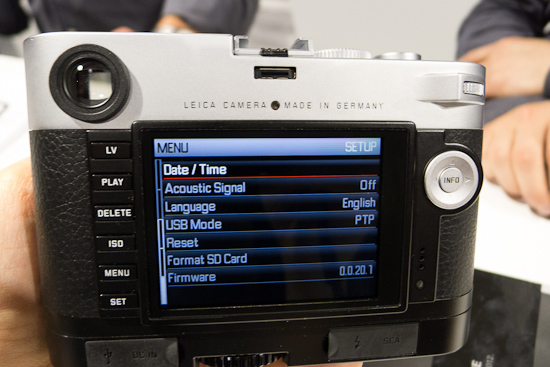
The Info button has been moved to the center of the d-pad and the Menu button has been moved into the left-hand column, right above Set. This makes sense since these are your two areas to manage settings and the Info button is now accessible with your right thumb while shooting. To that end, the D-pad has been raised up. The surrounding dial on the M9’s d-pad has been removed in favor of the thumb dial, which is similar to that found on the S and the X2. I found myself trying to zoom in on an image with the non-existent zoom wheel, but I quickly adjusted to the new handling method of using the thumb wheel.The bottom plate has been redesigned as well. The first thing I noticed was that the tripod mounting hole is not actually on the plate. It’s in the chassis of the camera and there is just a pass-through hole in the plate. This is both a blessing and curse. Say you are out shooting on a tripod and want to change the battery or memory card. You would have to unscrew the camera before being able to remove the base plate. This is the bad news. Quick release plates also become useless for the same reason. The good news is that mounting to a removable plate was never the best solution in the first place as it has far too much flex for really solid mounting. Mounting right to the camera is the most solid possible. Of course, my suggested solution as I was looking at this problem is to use one of the new hand grips.
Coming in two flavors, a standard hand grip and a multifunction grip, they both have a really great feel and add a lot to the camera. Both models have the same shape front grip which is eons better than the M9 hand grip. Nice, tacky textured leatherette/rubber covers the perfect shape. It is slightly angular and fit my hand just right. There is a screw hole on the side of the grip section for a finger loop a la M9 Titan. I never gave too much credence to these oddities, but after trying it on the M, I really like it. In case anyone wants to get me one as a present, I prefer the medium size. Thanks. The loop is rubber, but has a metal band inside for strength. It also comes in small and large.
The Multifunction Handgrip is slightly taller at the base than the Handgrip M to allow for electronics. There are four ports on the backside under two weather-sealed rubber caps. On the left side are a USB port for tethering to a computer and a power input for powering the camera externally. On the right is a PC sycnc socket and a new LEMO-style SCA connector for the TTL flash bracket accessory.
While on the big side and reminiscent of Leica, Hasselblad and Contax accessories from the 80’s, I’m sure wedding photographers will be very happy. The bracket screws into the bottom of the Multifunction Handgrip and allows you to use a TTL flash like the Leica SF 58 in full TTL off camera while also using the hot shoe for an EVF.
For tethering, the M will work with Leica Image Shuttle software and directly into Lightroom. Pretty sweet. I can see that Leica has plans for a wider adoption base than for previous M cameras. Oh, and a very cool trick of the Multifunction Handgrip is that it has a built-in GPS in the handle that automatically embeds GPS information into the file metadata. Awesome for travel and landscape photography as well as photojournalism. There's also a copyright entry menu to embed this data. Even better for PJs.
Coming back to the base plate, there is a sliver of the metal plate that is cut away and filled with plastic. This was done to eliminate signal interference with Wi-Fi SD cards. These guys think of everything it seems. Also changed from the M9 is that the interior is now all metal instead of a plastic lining. The plastic never really bothered me – it was hidden under the plate, after all – but the new design oozes quality through and through.
I also had a look at the battery. Yes, it is different, and bigger. The new battery has almost the same power rating (1800 vs 1860mAh) but features a much higher voltage of 7.4V (vs. 3.6 V). This is due to the need to drive the 3” screen for live view, both in terms of display power and sensor/processing power to capture info. The new battery, combined with more efficient (Maestro ASIC vs. generic DSPs in the M9) electronics allow the M to get around 400-500 shots in LV, which translates to about 5 hours continuous usage, or around 800-1000 shots using the optical finder. My suggestion is to carry an extra battery because you are going to want to use live. Yes, really.After a good once over of the new controls and the grips, I wanted to give the live view focusing a try and see how focus peaking was implemented. Wow. Live view just worked perfectly and the ability to quickly press the focus button on the front to bring up the focus peaking mask made it extremely useful. The focus peaking is very subtle, but very accurate, non-invasive, and ultimately successfully implemented. Areas of highest contrast are highlighted at the edges with a very thin red outline. It’s a bit difficult to describe and if you weren’t looking for it on the LCD, you might miss it. It’s very subtle, which is a good thing. Clearly, Leica understands that photographers don’t want added distractions.
Also, when in the focus peaking mode, you can turn the thumb dial which creates a magnified view on screen, adjustable all the way up to 10x magnification. I think the f/0.95 Noctiliux just got infinitely easier to master for an entire user base. This mode is useful to achieve rapid and very precise focus. To get back to the main view, just tap the shutter button lightly and it snaps back to the full image. The camera is extremely responsive, changing modes and playing back images with just about no delay.
Shooting is also faster. The M has a brand new shutter, made specifically for the camera by Copal. It is quicker in order to facilitate LV shooting. When you press the LV button, the shutter opens. When you depress the shutter to take a photo, the shutter must close, then open again to initiate exposure. While there was a slight delay, it was nothing like the delay experienced on DSLRs that I’ve used in live view. This should be fairly obvious as the M has no mirror that needs to move in addition to the shutter. When shooting continuously, even in LV mode, the frame rate has been increased to 3 fps. With a Maestro image processor and a 1GB buffer inside, the M churns through images even faster than the S2, which makes a lot of sense as the files are 50% smaller.
I also took a peak through the optical viewfinder to find that 1) it was still there and 2) the LED-illuminated frame lines look identical to those in the M9 Titanium. The frame lines are still in three sets: 28/90, 35/135 and 50/75. My guess is that the mechanical cam is still employed to move the traditional frame mask, but the illumination is now all internal. The frame lines change illumination based on ambient light and can be user set to either red or white. The red looks more high-tech, but the white is classic.
Having said all that, I barely used the optical finder in my test. Live view, either on the gorgeous 3” 920,000 pixel LCD screen with Gorilla Glass or through the 1.4 MP EVF 2 is really that good.
Another cool feature was shown to me in the menu. If you turn on Auto Focus Assist, the camera will switch to focus peaking anytime you move the focus ring to refocus without having to press the focus button on the front of the camera. How does this work? Well, those Leica engineers are very clever. They have a sensor on the old rangefinder focus arm to tell when it’s been moved. Cool. And, it worked as advertised, making focus peaking that much more useful without having to fiddle with the camera.
So, the camera worked well with the few M lenses I tried. C’mon, it’s an M camera after all. What about some beefy R lenses? Henning brought out the R Adapter M and a 28-90mm zoom. The adapter is fairly small and features a tripod foot, which the camera will balance on without toppling over. It is also 6-bit coded and the M brings up a corresponding selection of 20 or so R lenses on the LCD.
This is for metadata as well as for correcting any optical vignetting. For what’s it worth, I was told that the corrections are extremely minor and mostly unnecessary. But, if the metadata is embedded, this means that the upcoming R lens profiles in Lightroom will be much easier to apply. And these, with corrections for distortion, will be very useful, indeed.
With the handgrip and EVF attached the camera balanced beautifully with the largish 28-90 mounted. It didn’t feel front-heavy the way I expected it to. In fact, the camera didn’t feel like an M at all. It somehow morphed into a small DSLR with a perfect balance and grip. The 28-90 zoom felt great on the camera. It was just a great focal length range and focus with the magnification and peaking was spot-on. I had to ask if Leica had considered manufacturing this lens again. Of course, this wasn’t something anyone wants to comment on and I highly doubt the prospect. But, if we leave reality for just a moment, I think R zooms would do extremely well in the marketplace, better than they ever did on the R system in later years. If you use the 28-90 on the M, you’ll want one immediately. I propose a petition. Who’s with me?
I switched lenses and put the 100 APO-Macro on. Yes! A real macro lens on the M. I racked that baby out to minimum distance and moved my body until the top dial of my X2 snapped into focus (using peaking, of course). Bam. Easy. I then pulled it up for a portrait of one of the Leica guys. Easy. I was falling more and more in love with the idea of this M being one of the best R cameras ever made. And this is coming from a die-hard R9/DMR user. Many R users have expressed concerns of an EVIL R solution. Rest assured that the M is not a kluge. I have a few choice R lenses in storage that will find a very happy home on the new M.
The entire menu interface of the camera has been redesigned to be more modern and to take advantage of the additional screen real estate. The Info display shows more information at a glance.
The menu, while still a long, scrollable list, is very easy to read and navigate. I discovered that if you go into a menu option but want to back out, you can just press the Menu button to return to where you were. This is a big improvement over the M9. Also, with a unified firmware kernel many features previously only found on the S are now available for M shooters. Clipping definition, long exposure time selection, selectable and manageable user profiles, as well as lossless DNG compression all make their way from the S2 and look awfully familiar to an S user like me. I think this is great, and so do the Leica guys. Unified control structures, shared code and the same processing methods can now be shared across product ranges. This speeds and simplifies development and allows users of both systems to benefit from common advances. Hopefully, a future X camera will join the fold too.
Some features are entirely new to Leica in general, like focus peaking, virtual horizon, and video recording. All work great, even on these early models. I tested out the video, and while I have always shunned video for still images, the idea of capturing Leica-like images in full 1080p with Leica R and M glass is scarily alluring. Clearly, video power users are in search of great optics and options from Canon and Nikon aren’t ideal. This is why Zeiss ZF, ZE and CP2 lenses are in such high demand. Imagine when videographers have the potential to use legendary Leica optics like the Noctilux, 90 APO, 21 Lux, 35 Lux, etc. on the M. I have a feeling we’ll be seeing a lot of video shot at f/0.95 in the near future.
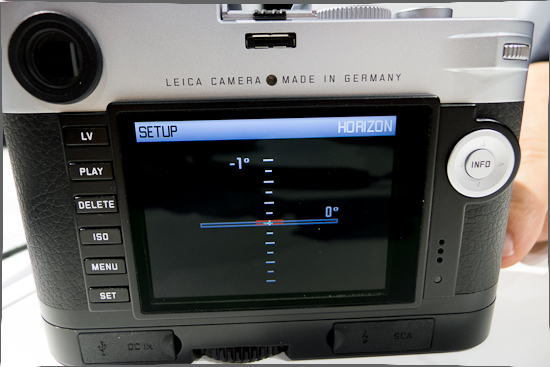
…on a more level surface.The video files are stored as single frame captures and put into either MotionJPG or MOV containers. This allows very clean, frame-by-frame editing with no bleeding between frames. Given the reduction in capture size of 1920×1080, ISO performance is even better for video that it is for stills. Essentially, pixel binning is being employed to scale down the captured image from the sensor. Currently, video capture is limited to 4GB per clip, which translates to around 30 minutes of full HD video. One potential pitfall for American users is that the default video setting is 1080/25p, which is standard in Europe, but not in the States. The second option is for 1080/24p. Just be aware of changing this when you get the camera and shoot video.
For audio capture to go along with the video, there is a mono mic on the top deck, which will be fine for quick captures but not anything serious. For better audio fidelity, Leica will offer a Stereo Mic adapter, which is slid into the hot shoe just like an EVF. The downside is that you can’t use the EVF2, but I suspect most video producers prefer the LCD for composition. The stereo mic can also be unplugged and you can plug in a standard 3.5mm stereo mic jack. This will allow the use of lavaliere, boom and shotgun mics. I was warned, though, that not all microphones will work even if the plug fits. Voltages can vary and only compatible microphones will work. I do wish that a video grip is offered in the future which has stereo mini-XLR and 3.5mm input in addition to external power. This would free up the hot shoe for an EVF and allow more professional audio options.
The one thing I haven’t written about is the image quality. Well, I haven’t been able to evaluate any files from the camera, so this will have to wait for another day. If I went purely from what I saw on the LCD, then I think we are in for a real treat. Leica worked very diligently to produce Leica-like image quality from the Leica-exclusive 24MP CMOS sensor . Leica also designed the processing board and sensor board to exacting specs. There isn’t a single piece of off-the-shelf hardware in the M and the R&D team controls the entire imaging pathway from lens to file. Let’s just say I have faith that the M will more than deliver the goods.
Keep in the mind that what I’ve written so far isn’t even all the information I gleaned from my time with the new M. But, I do think we are approaching the point of information overload and I need to get some rest for Day 2. If you have any questions, please send them my way by way of comment and I’ll do my best to answer.
If you’d like to pre-order the M, please do so at Leica Store Miami. The camera and accessories are available for order online or on the phone at 305-921-4433. Your credit card will not be charged until the camera is shipped to you.
-
Leica Store wrote a new post, Photokina 2012: Leica Das Wesentliche Event in Cologne 13 years ago
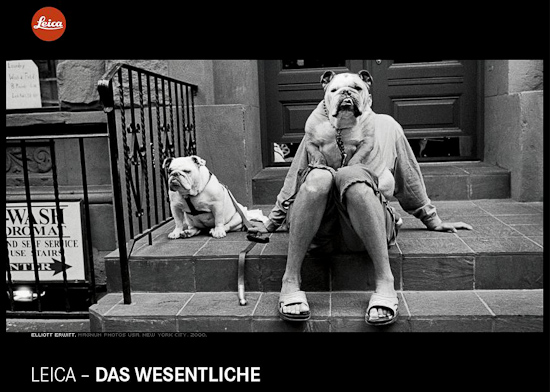
Leica has been even more secretive than usual lately. Many of my readers and customers assumed with my past early access to the M8, M9, MM, S2, etc. that I knew something about what was coming. Well, I can now honestly say that I really had no idea. And you know what? It was a lot of fun speculating and trying to predict what Leica was going to unveil at this event. And, it was equally exciting standing there next to the stage as the new products were revealed.Near the South Entrance to the Koelnmesse, ladies in bright orange traffic vests holding Leica signs were directing attendees toward a tent set up in a parking lot. After I had passed into the tent and presented my ticket, I received a very snazzy Leica Das Wesentliche rubber wristband. I’ve still got it on and I think I’ll probably continue to do so throughout the show. It really does make the ultimate fashion statement.
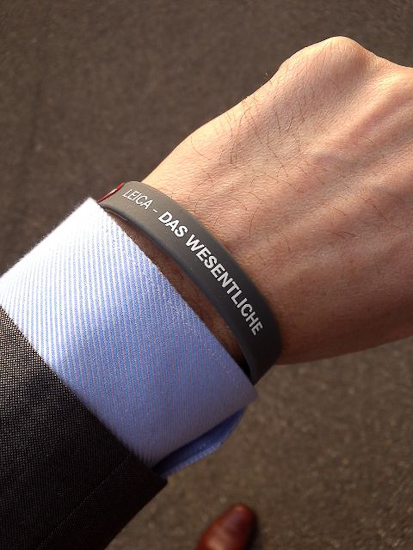
Getting off the freight elevator, I made my way into the enormous Hall 1. I wrote earlier that Leica is taking the entirety of Hall 1. Their booth this year is about 54,000 sq ft, roughly ten times the size of the one they had two years ago at the last Photokina. And, with such a big space, I guess they figured they might as fill it up for this event. In spite of the voluminous room, eager attendees were packed in wall-to-wall. I saw no shortage of familiar faces and made my rounds before staking claim to a spot just off to the side of the presentation stage.
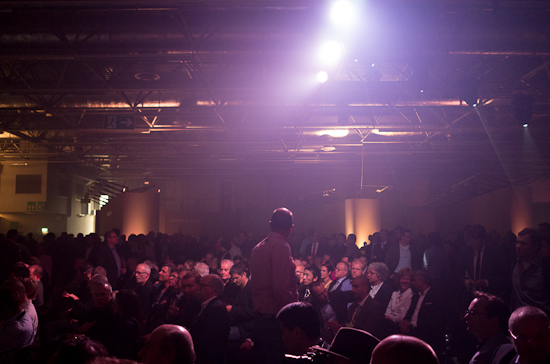
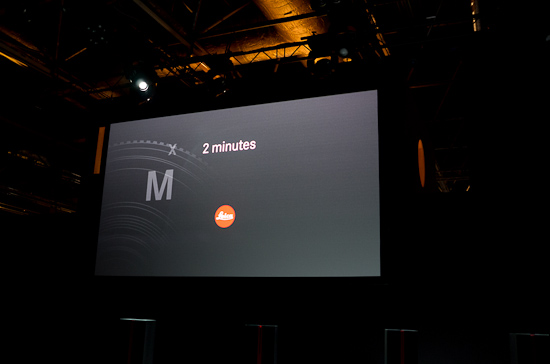
The large screen behind the stage, flashed a countdown every minute until finally, the emcee took the floor. The German TV personality cracked a few jokes and brought up Leica CEO Alfred Schopf. Schopf cracked a few of his own jokes (“CEO stands for Chief Entertainment Officer”) before getting down to business.He started talking about Leica’s 99th anniversary. As Schopf pointed out, most companies would wait another year to celebrate their centennial. Leica, he explained, is not an ordinary company. He went on to explain that the number 9 is also a significant one to Leica. On 9/9/9, nine new products were announced, including the M9. So, a 99 year celebration seemed fitting. To commemorate, a special coffee table book has been made. Originally, it was supposed to have 99 photographs, but once in the design, this number was cast aside and forgotten in favor of great design. From Leica heritage to iconic photographs, the book looks really nice.
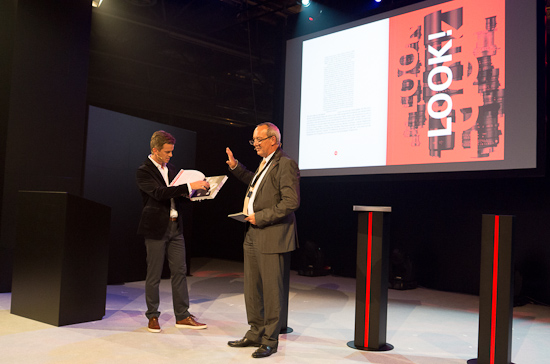
Next, Karin Kaufmann, Dr. Andreas Kaufmann’s wife got up on stage. Apparently, Andreas wasn’t feeling too well, which was a shame, as he always brings a certain flair as master of ceremonies. Karin explained that Andreas had always wanted to “change the world” after he had attended protests in 1968 against the conflict in Vietnam. One of the images that changed his outlook on the world was Nick Ut’s Pulitzer prize winning photograph of a family fleeing a napalm attack. This year marks the 40th anniversary of this shot.
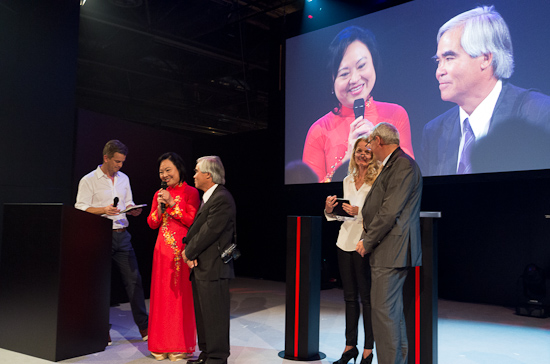
Then, after this story, she invited Nick Ut and Kim Phuc, the girl in the photo, to join her on stage. Almost immediately, a huge crowd gathered in front of the stage with cameras firing off like the paparazzi at the Oscars.
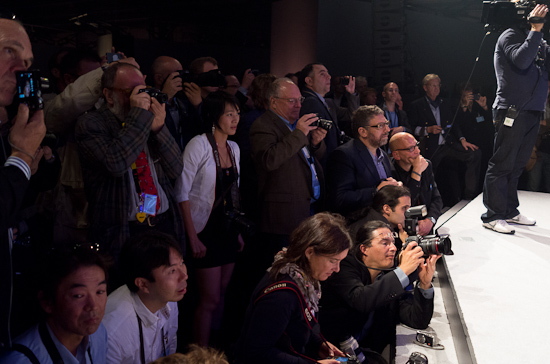
Ut was presented with the Leica Hall of Fame award for his lifelong work with Leica in the creation of powerful images. Nick explained that his first thought was rescuing Kim and the other children. Immediately after taking the now-famous photo, he rushed her off to a hospital in Saigon, where she stayed for 14 months, barely surviving the burns covering her back. Phuc now runs a foundation that helps children who are victims of war. Hers was truly a story of rebirth and hope in the midst of despair. And, if this wasn’t enough to hear their story recounted in their own words, they were then joined on stage by another war photography legend, David Burnett.
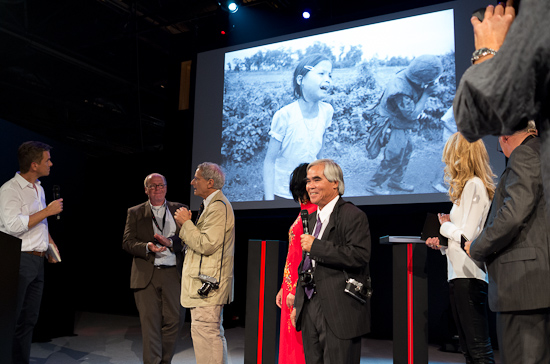
He was standing next to Ut at the time. Burnett showed some of his own images on screen while explaining more how they saved those children. According to Burnett, he missed the shot because he was reloading. They had no idea this going to change the attitude of the Vietnam War the world over, but rather, it was just another day in the life of a war correspondent, documenting the action.
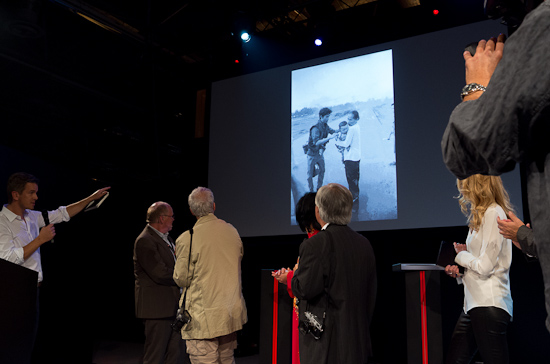
Then, past Leica Hall of Fame recipients Steve McCurry and Barbara Klemm came up as well. McCurry talked about the famous photo of the girl in Pakistan that graced the cover of National Geographic. Years later, he tracked her down and offered her compensation for the use of her image, which had been printed hundreds of thousands of times, but for which she never had received a cent. Klemm discussed her experience shooting world leaders over the course of her career. Unfortunately, the discussion was in German so I can’t recall the exact sentiments.All together, they had a brief discussion about photojournalism. Mrs. Kaufmann had prefaced her presentation to say that there were many notable guests in attendance, but I was surprised by the sheer caliber of these photographic legends. Everyone then gathered to have pictures taken by the throng of photographers in front of the stage, then Mrs. Kaufmann went on about the gallery exhibitions in the rear of the event space.
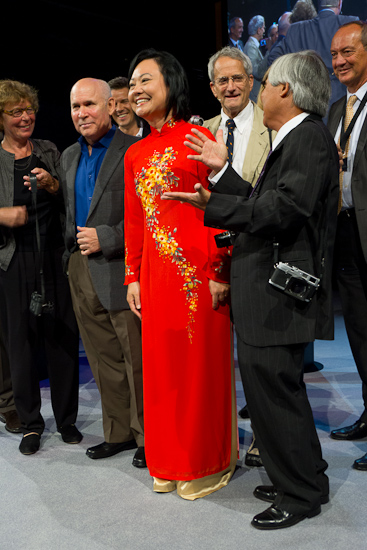
In the past, Photokina had used the space to exhibit various photography, but this year, the entire space is dedicated to Leica photographers. Twenty photographers have been highlighted, each with their own exhibit in the gallery space. From Elliot Erwitt to Nick Ut to Platon, this is a not-to-miss collection of some truly amazing work. And with the intro, the lights in the gallery area came to life. We had an hour to get more food and drink and to admire the great photographic works in the gallery.
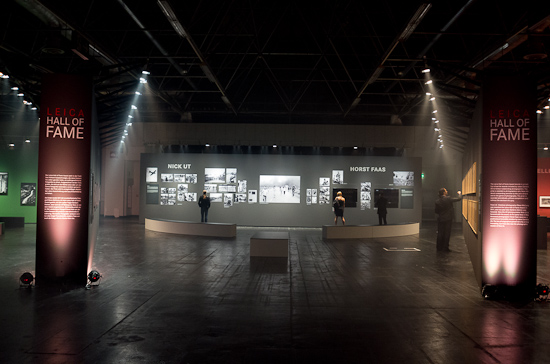
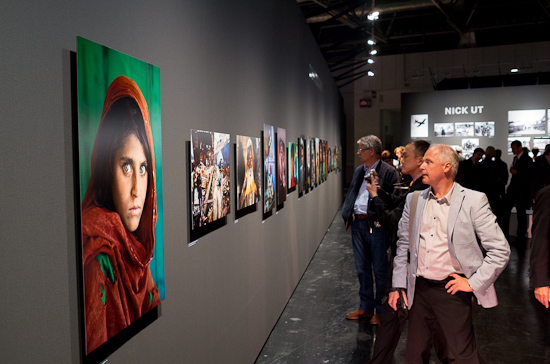
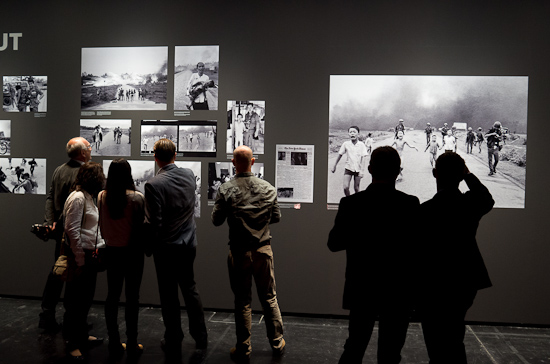

Even though I was anxious to hear about the new products, I felt the program so far had been really extraordinary. The wait would be over soon so I wandered around, enjoying the great photography displayed and chatting up a few old friends like Christian Erhardt, former VP of Leica USA.
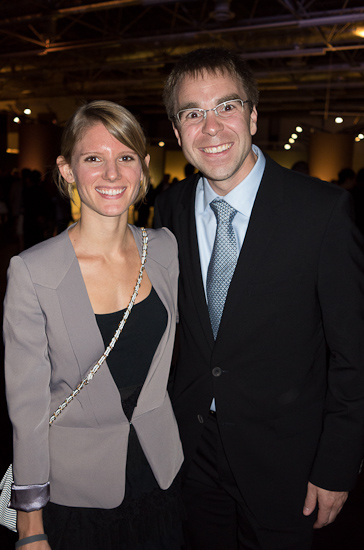
Kelsey Fain, S-System Specialist with Christian Erhardt, former VP Leica USA

Jesko von Oeynhausen, product manager for M
The countdown started again on the big screen. I retook my position in front of the stage. This was the big news and I didn’t want to miss a thing. This time around, the throng of photographers decided to stake their claims in the front as well.
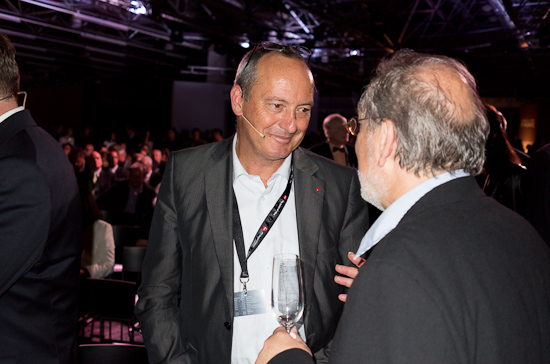
Schopf retook the stage. Since 2009, Leica’s product strategy has proven to be extremely successful and the company has been rewarded with profitability and growth. There were so many new products for 2012 that Leica decided to introduce some in May and the rest at Photokina. The two May products, the M Monochrom and the X2, have been doing very well.
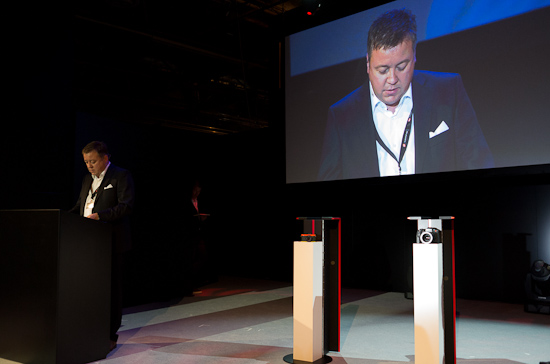
At this point, head of product management Stefan Daniel came up to talk about the new products while Schopf played Vanna White, opening each of the four pedestals with a new product inside. Leica collaborated with famous British fashion designer Paul Smith to create a special, limited edition. The Leica X2 Edition Paul Smith is a very boldly British styled camera. With a daring orange top plate, lime green base plate with British racing green leather in between and contrasting black controls, the run of 1500 cameras is certainly not for everyone.
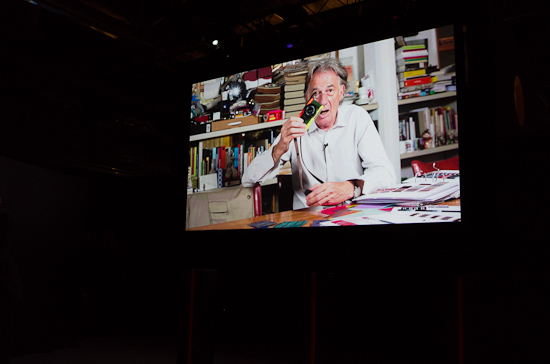
Paul Smith via video intro
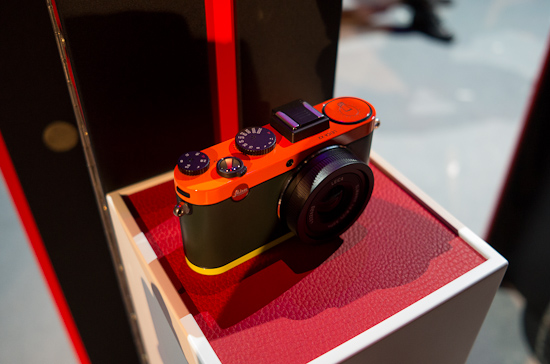
But, for those looking for a really wild and unique design of an amazingly good camera (see my
full X2 review for more), it just might fit the bill. The Paul Smith Edition will only be available at Leica Stores and Boutiques. Pricing is not available at this time. Also new is the X2 a la carte program. I’ll get more details on this later in the week.
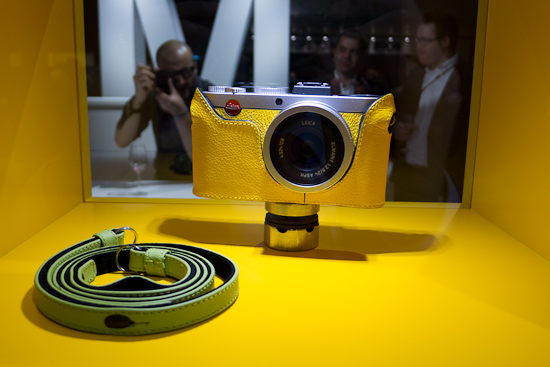
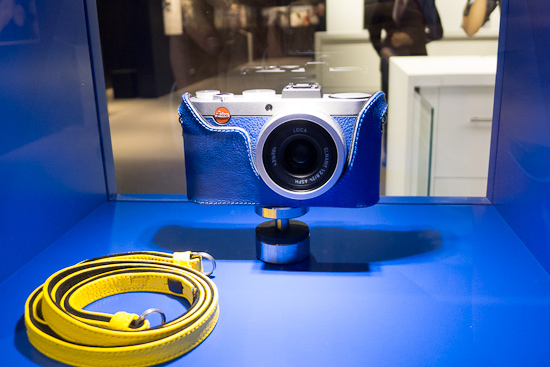
Next up, the New S. Not an S3, mind you, but just The New Leica S. The New S has been upgraded all around. Featuring double the RAM at 2GB, the camera now has a much deeper buffer than the S2, and is capable of shooting up to 32 continuous images at 1.5 fps without slowing down. This is class leading. Also new is the completely revamped AF system with white balance sensor, the 3” 920,000 pixel LCD with Gorilla Glass and full sRGB color gamut, brand new sensor board with extended ISO range from 100-1600, increased viewfinder coverage, new 5-way controller on the rear of the camera, built-in auto-level, standard GPS and lighter chassis. The new S camera also has a brand new menu and on screen control structure.
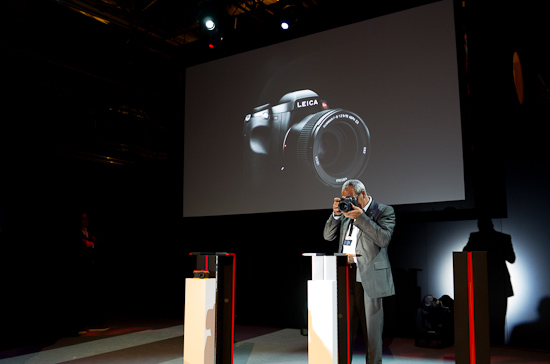
Also new are three lenses: the Super-Elmar-S 24mm f/3.5 ASPH, Vario-Elmar-S 30-90mm f/3.5-5.6 ASPH and TS-APO-Elmar-S 120mm. This will now bring the total to eight lenses, with five of these also available soon in CS version. Additionally, the Leica ELPRO-S 180mm macro close-up attachment will be available for the 180mm APO, giving the lens much more flexibility.
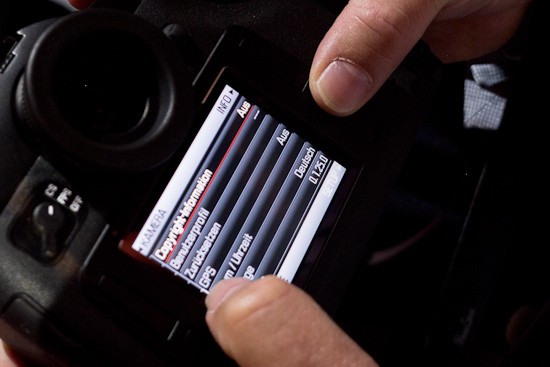
New S LCD and menu
I will be taking a much closer look at the S System and the camera while at Photokina.Two down, two to go. In the third mystery pedestal was the Leica M-E, or the Essential edition of the M. Finished in two tone “panda” with silver control dials and anthracite gray top and bottom plates, the M-E features the same 18MP sensor as the M9, but does away with the fame preview lever and the USB socket. These were two rarely used items in the M9, but a good way to cut the cost. The M-E will offer a cleaner M9-like experience for $5,450.
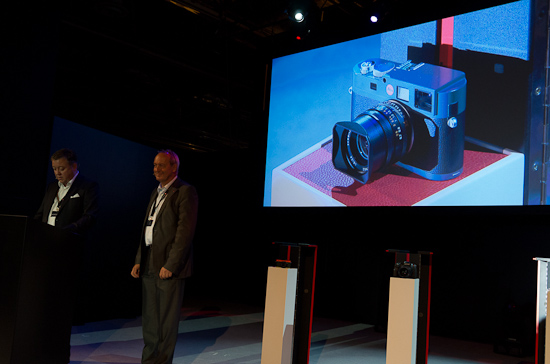
Instead of Stefan announcing the final product, Dr. Kaufmann came up to the podium. Clearly, he was feeling better and wanted to save the best for last in the spirit of Steve Jobs. He proudly proclaimed that there was no M10 and had a good little chuckle. “Well, it’s not called the M10,” he went on, “It is just the New M!” As he explained, there have been over sixty years of M cameras but they have all been Ms. Now, and in the future, the M and S cameras will just be called the M and the S. After mulling it over the last few hours, I’m okay with the new naming. It works for the Apple Mac Book Pro, for instance. Or for many car models. I’m sure it will be fine.
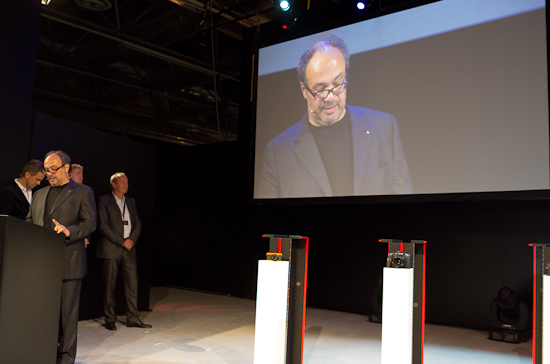
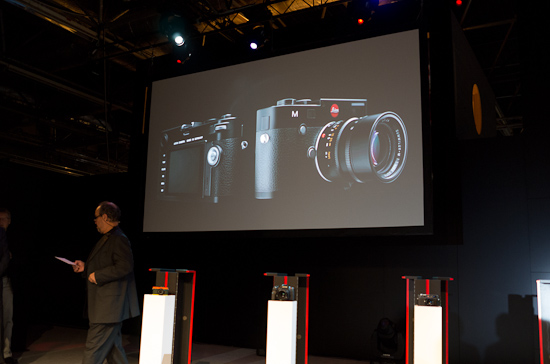
The New M has a specially made full frame 24MP CMOS sensor, Maestro image processing chip from the S system, live view, the same 3” 920k LCD from the S, live view, live view focusing, focus peaking, 1080p video recording, LED-lit frame lines in the optical rangefinder, a new menu system, added quick buttons and thumb wheel for exposure comp, and full weather sealing. And, of course, lest we forget the new R adapter. This was indeed the EVIL solution that Stefan was alluding to two years ago. As with the S, I will cover the new M in depth later this week.
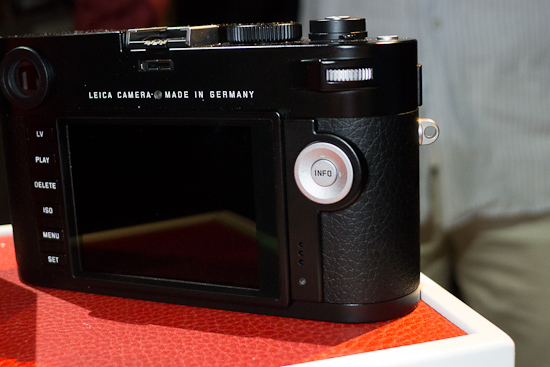
For a super exclusive camera, Jonathan Ive, Apple’s chief designer will be creating a one-off Leica M camera to be sold at an auction for charity. I have a feeling this is going to go for a lot. I’m curious with what Mr. Ive comes up with.And, with that, the product announcements were over and the party was in full swing. No M lenses and the various compact digitals like the V-Lux 4 and D-Lux 6 were mentioned. Clearly, the event was focused on core products Made In Germany.
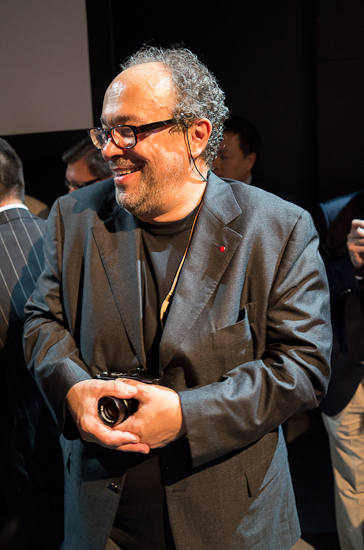
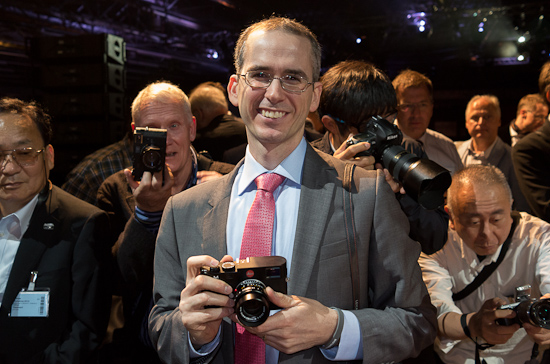
Me, holding Leica M
Immediately, that horde of photographers camped out in front of the stage swarmed around the new products. I got a chance to hold the cameras briefly, but not long enough to draw any conclusions. Fear not, though, I’ll have plenty of opportunity at the booth. I also got to meet Nick Ut and have a photo with him. I’m not usually a sucker for celebrity but this guy is a legend and it was an honor to meet him. Too bad I didn’t have a book to sign.
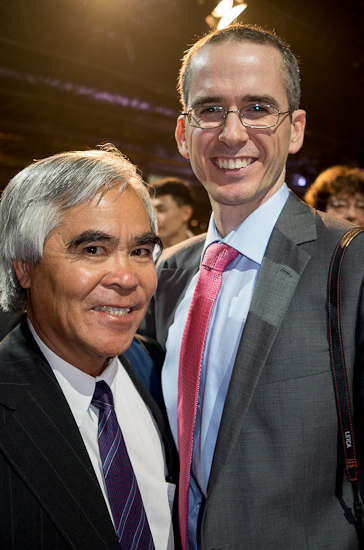
Me and Nick Ut
Everyone’s fun was broken up by staff clearing away the new models along with their pedestals. Then, a band started to set up. Perfectly normal I thought. They had some local band in Berlin at the end of the party. Well, a few minutes later, when Seal came out, I wasn’t the only one shocked. He did a full set, which was amazing. That guy can really sing. In between songs he waxed poetic about the common bond of photography and his passion for Leica. Clearly, everyone in attendance thoroughly enjoyed the show. Seal finished his set and disappeared.
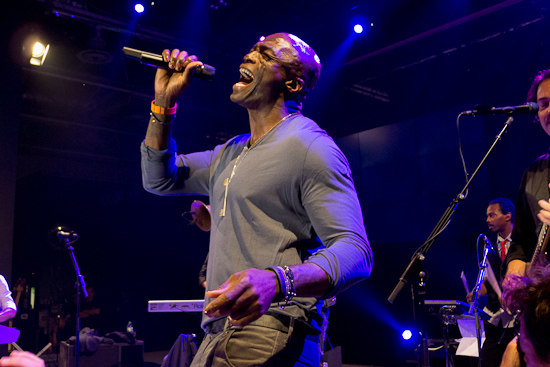
The DJ came out and the party was still hopping, when I decided to call it a night around 1am and head back to my hotel.
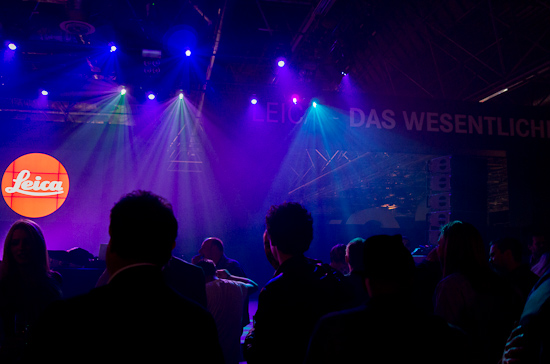
After the long night and some serious jet lag, I think I’m going to sleep in just a little, then head to Photokina. So far, I’m really impressed with the Leica offerings and can’t wait to get hands on at the show today. Stay tuned for more updates here on Red Dot Forum and on Twitter (@RedDotForum). -
Leica Store wrote a new post, A Few Thoughts on the New Leica M Products 13 years ago
After an incredible day of announcements from Leica, there are a slew of new products in the Leica lineup. My thoughts on a few:
Leica M: The highly anticipated successor to the hugely popular Leica M9, this looks like a dream come true for me. As a frequent user of the M9, I can't say there are too many things I would improve upon, but as usual, Leica has exceeded my expectations. A few of the most exciting improvements:
- A new, 24 megapixel full frame CMOS sensor that promises to offer fantastic high ISO performance (ISO6400!).
- Live view with focus peaking for precise framing and focusing
- Optional electronic viewfinder
- To go along with live view, a new adapter that allows the use of Leica R lenses. Hello super telephoto and macro!
- High resolution, 3 inch, 920k dot LCD screen
- Improved battery life
- Multi-pattern and spot metering (the M9 had only center weighted metering available)
- Full HD video capture with an option stereo microphone attachment
- Weather-resistant body
- Maestro image processor – this is similar to what's found in the Leica S and S2
Basically, this is a laundry list of everything I would have wanted improved or added from the M9. Most excited of all is the ability to use live view for super-accurate focusing, along with the ability to use an entire lineup of new lenses. Previously the longest lens available for the M was 135mm. Now with the R system, you can use an 800mm lens on your digital M camera! I am confident this will be the best-selling Leica M camera of all time. It still looks and works like a classic M, with all of the modern features that make it versatile to a wide variety of users.
Along with the new M, a few new accessories have been released. The most interesting of the group is the new Leica M Multi-functional handgrip which has a few unique features. It will allow tethered shooting with the Leica M, GPS geotagging of images, the ability to use an AC adapter for unlimited shooting time, and the attachment of finger loops, first seen on the M9 Titan.
Leica M-E: This new offering combines the well-loved, 18 megapixel CCD of the M9 in a new and lovely anthracite grey body. Priced at $5,450 this is a great way to get into a digital, full frame Leica or for a second body. I think it is a very smart move from Leica to offer their customer base this new camera, a slight refresh of a timeless classic.
Overall, an extremely productive day for Leica and an exciting group of new products. Stay tuned for more!
-
Leica Store wrote a new post, Leica Announces Leica ELPRO-S 180 13 years ago
Today at Photokina Leica has announced the new Leica ELPRO-S 180 which adds close-focusing capability to the already superb Leica APO-Tele-Elmar-S 180mm f/3.5:
Solms, Germany (September 17, 2012) – Leica […]
-
Leica Store wrote a new post, Leica Announces the new Leica TS-APO-ELMAR-S 120 MM F/5.6 ASPH. TILT/SHIFT LENS 13 years ago
Today at Photokina, Leica has announced the new Leica TS-APO-ELMAR-S 120 MM F/5.6 ASPH. TILT/SHIFT LENS:
Solms, Germany (September 17, 2012) –Leica Camera presents the Leica TS-APO-Elmar-S 120 mm f/5.6 […]
-
Leica Store wrote a new post, Leica Announces the new Leica M-E 13 years ago
Today at Photokina, Leica has announced the new Leica M-E digital rangefinder:
Solms, Germany (September 17, 2012) – Leica Camera presents a new model in the Leica rangefinder system, the Leica M-E. […]
-
Leica Store wrote a new post, Leica Announces the new Leica SUPER-ELMAR-S 24 MM F/3.5 ASPH. 13 years ago
Today, Leica has announced the new Leica SUPER-ELMAR-S 24 MM F/3.5 ASPH. for the Leica S-System:
Solms, Germany (September 17, 2012) – Leica Camera has expanded the Leica S medium format system with the […]
- Load More

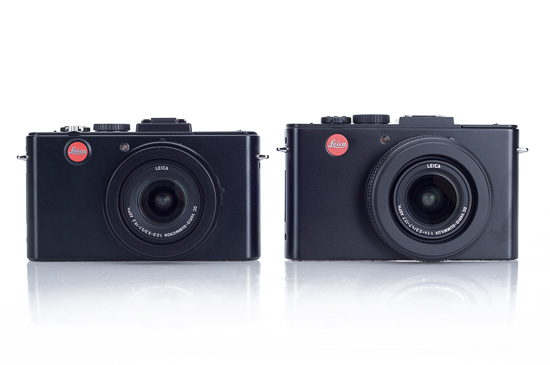
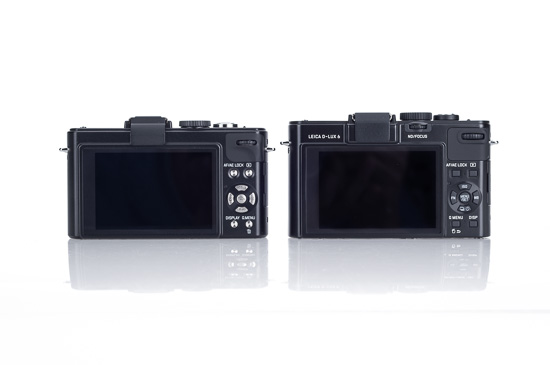
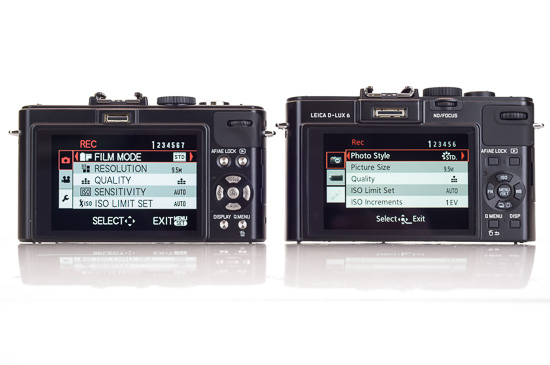

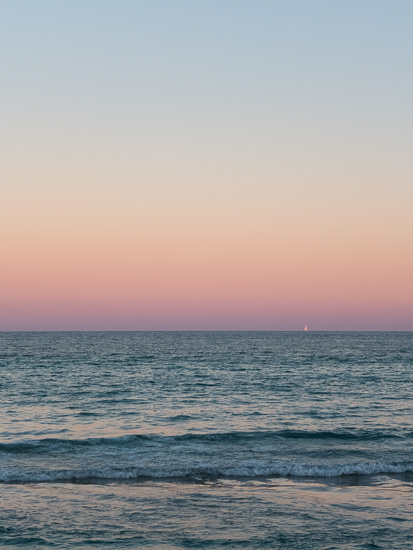

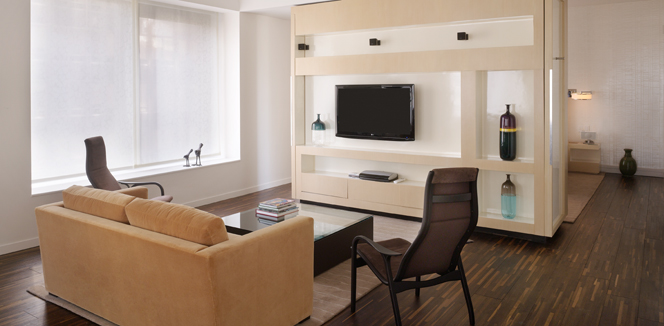
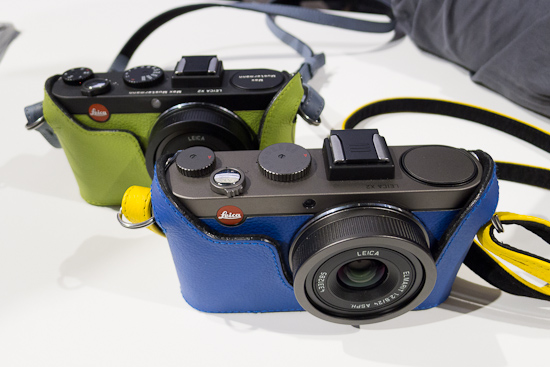
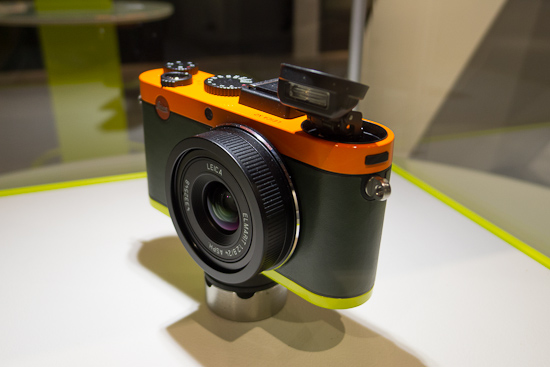
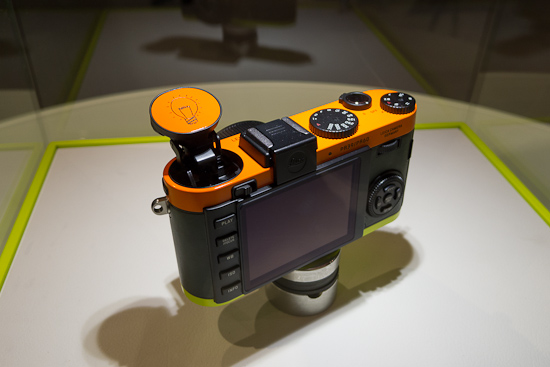
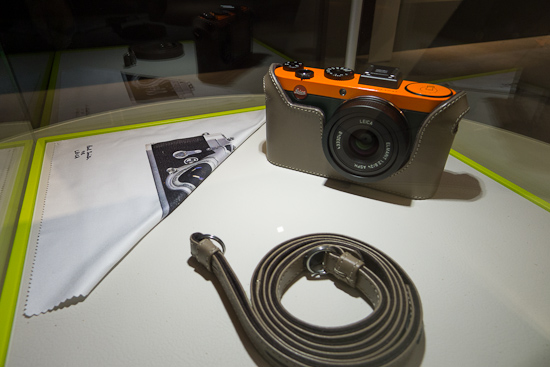
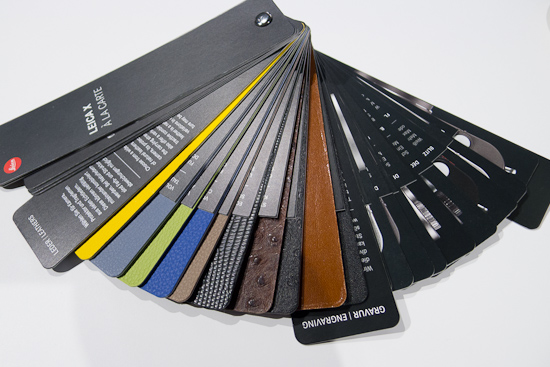
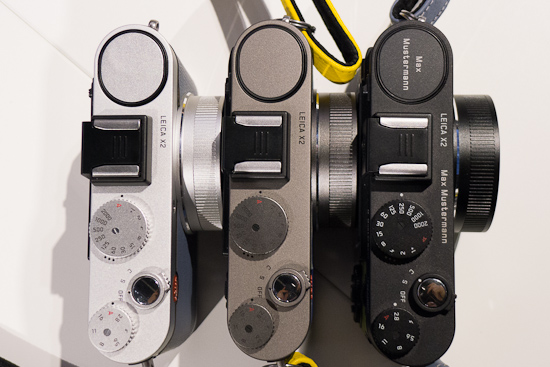
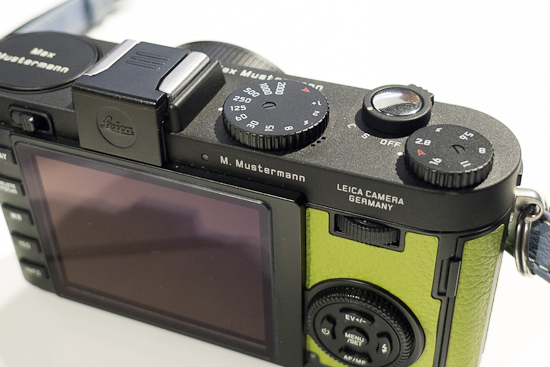
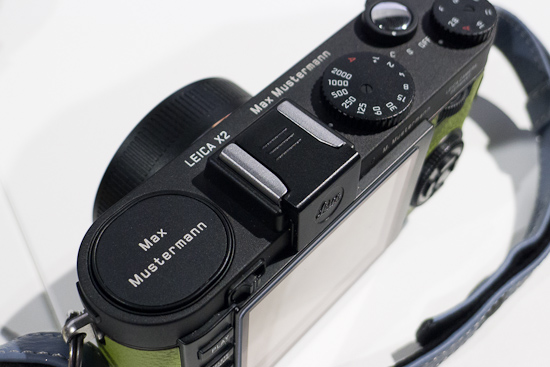
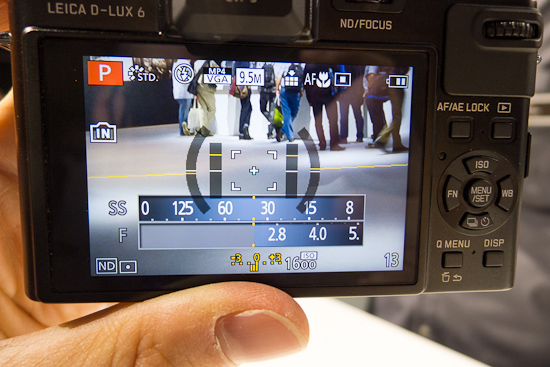
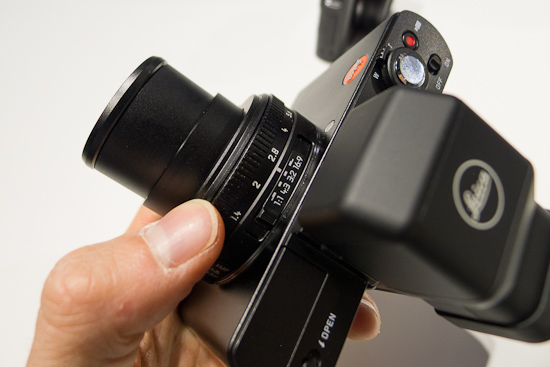
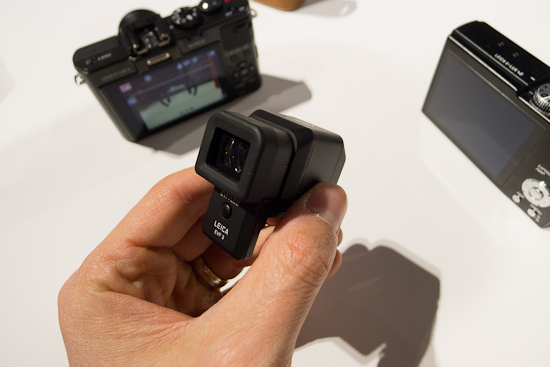
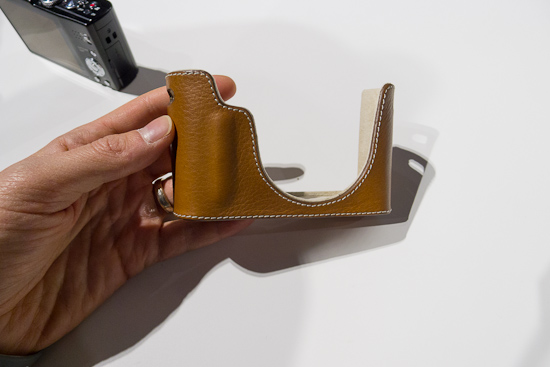
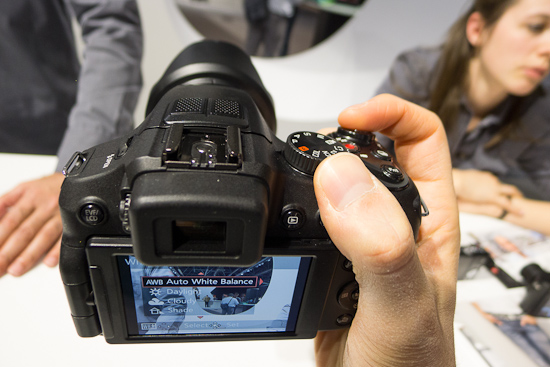


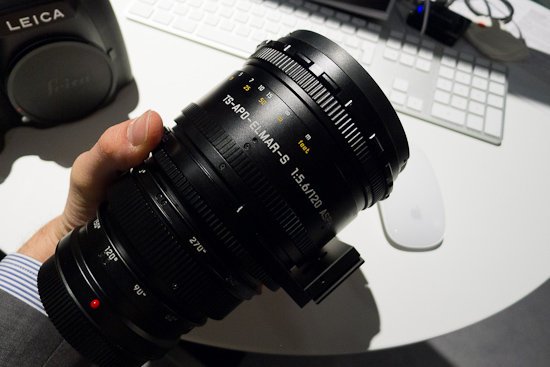
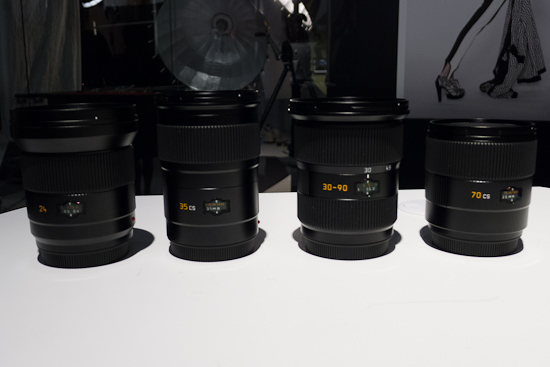
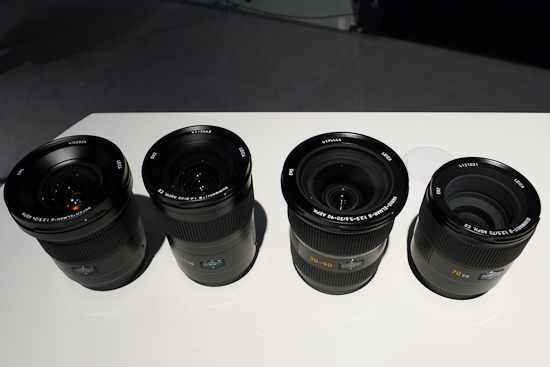
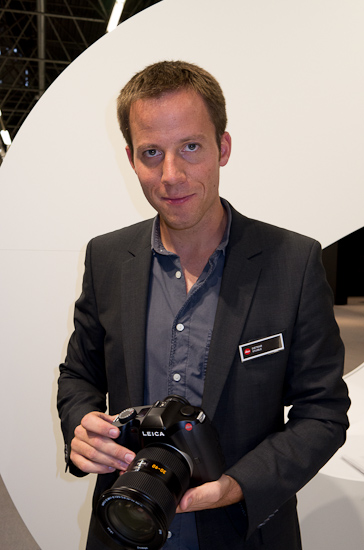
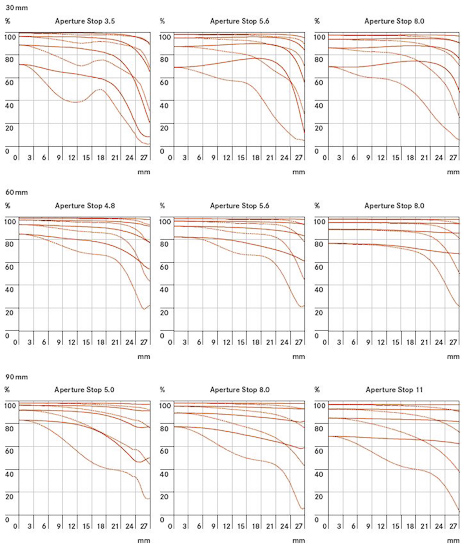
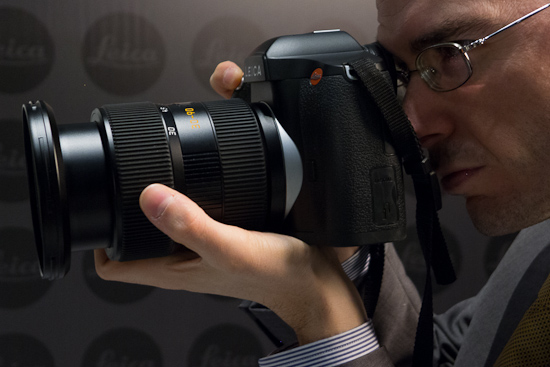
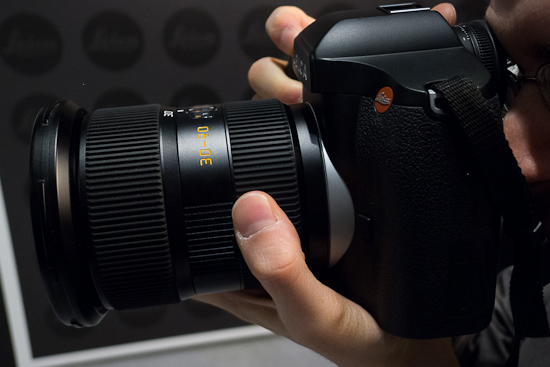
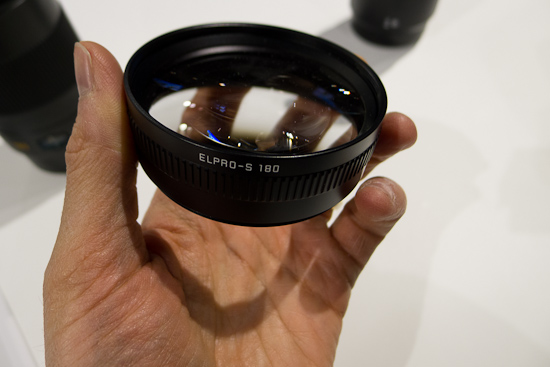
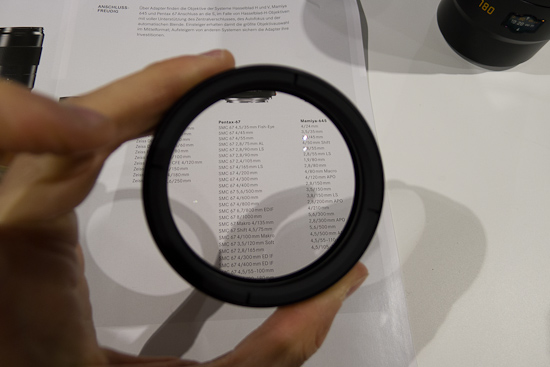
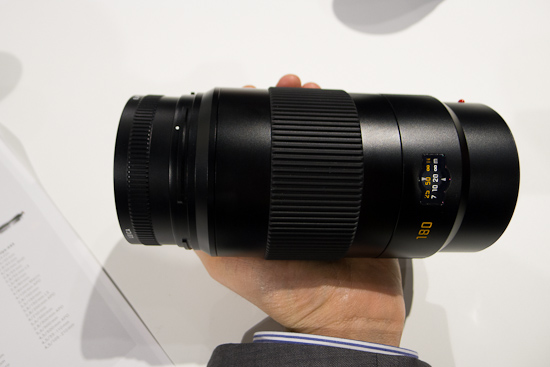
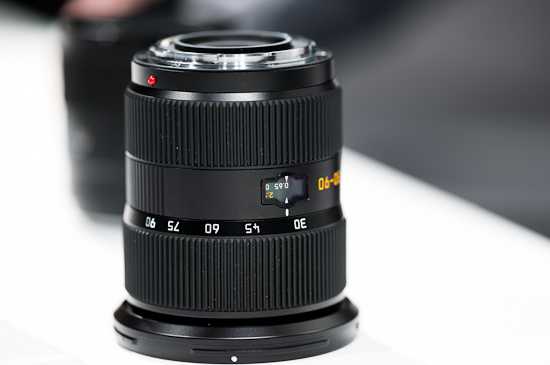
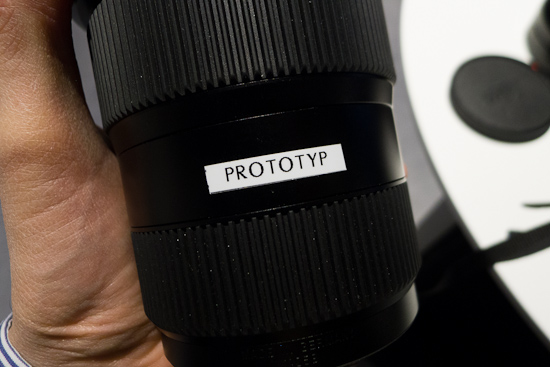

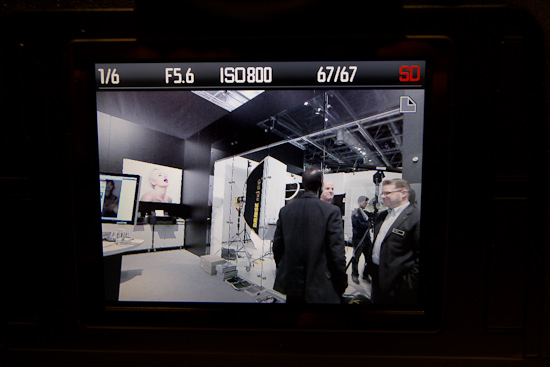
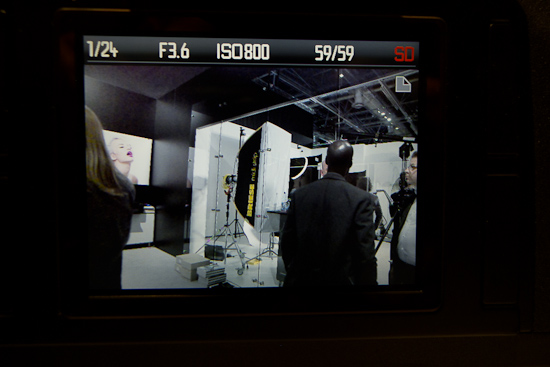
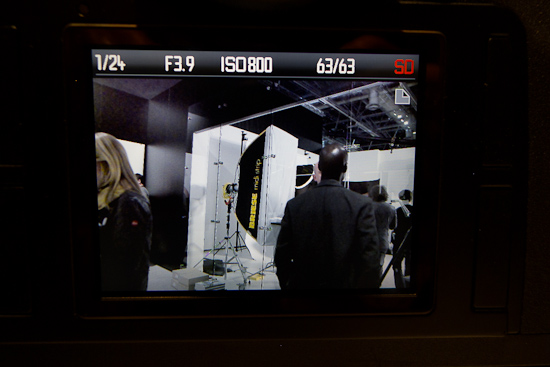
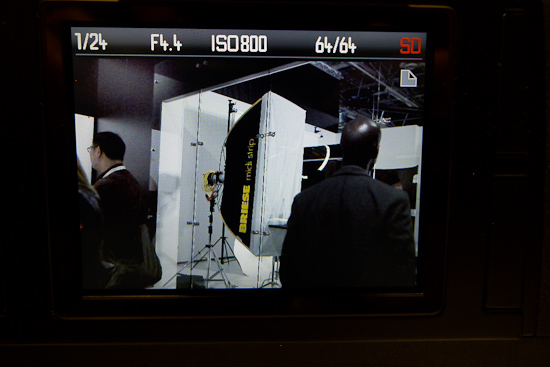
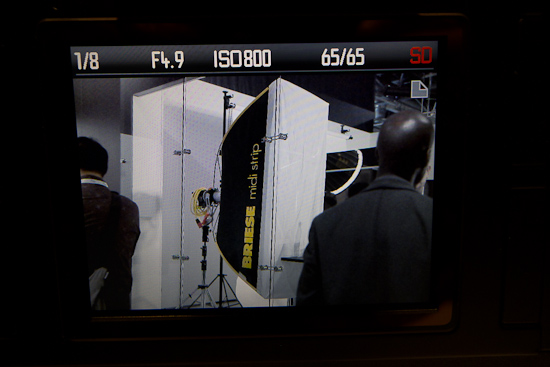
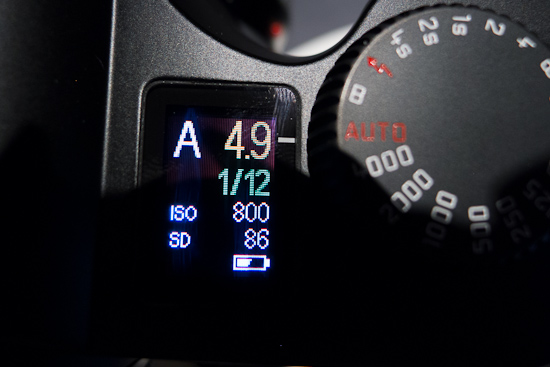

























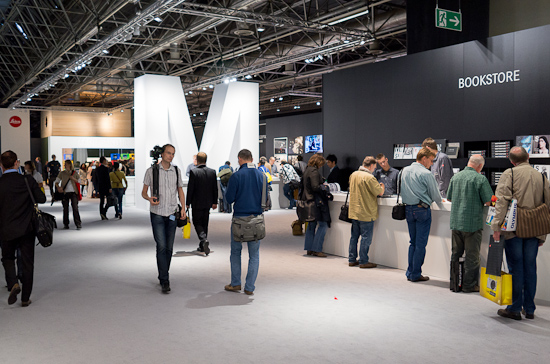
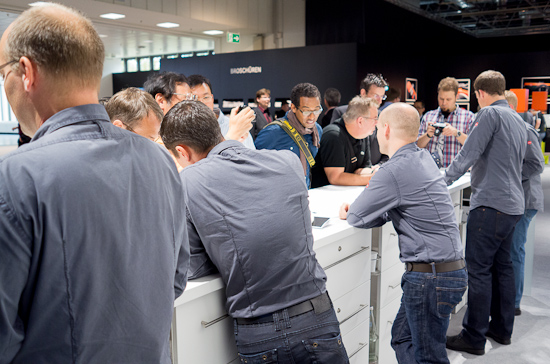
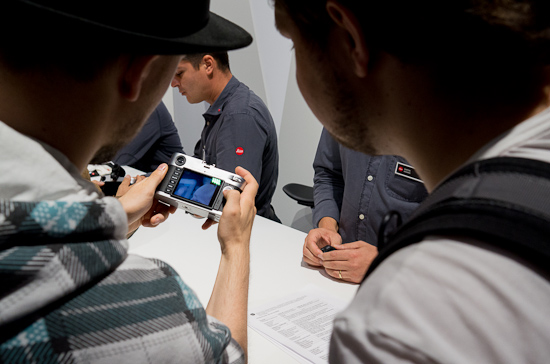
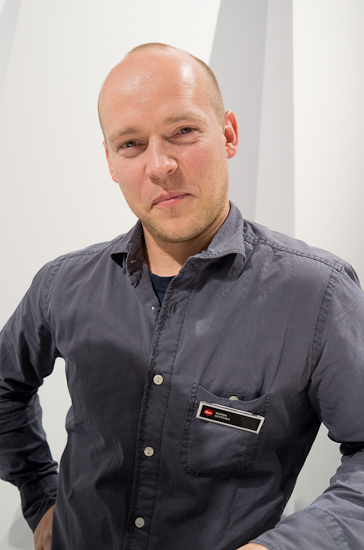
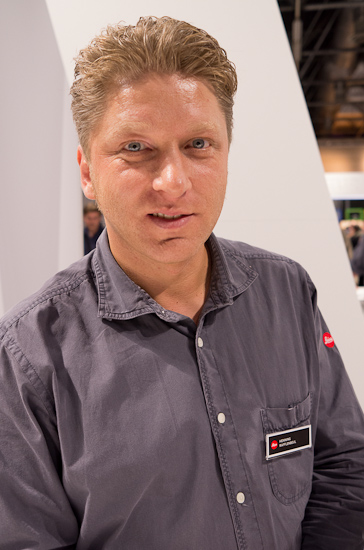
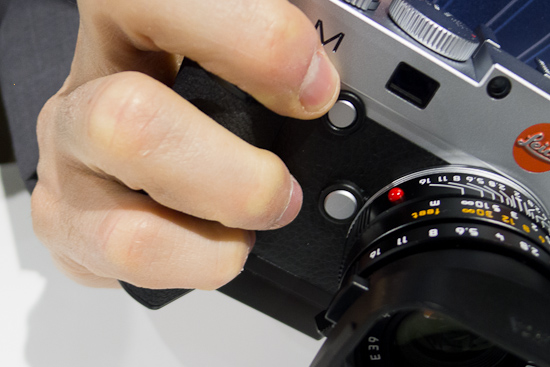
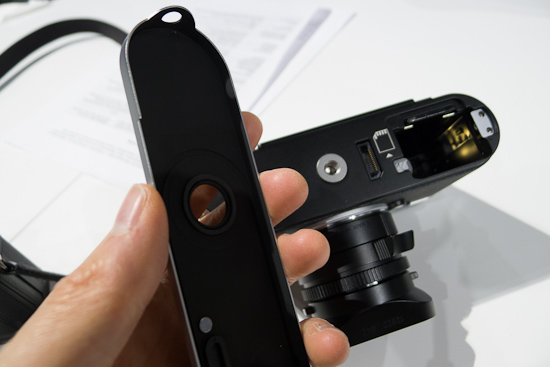
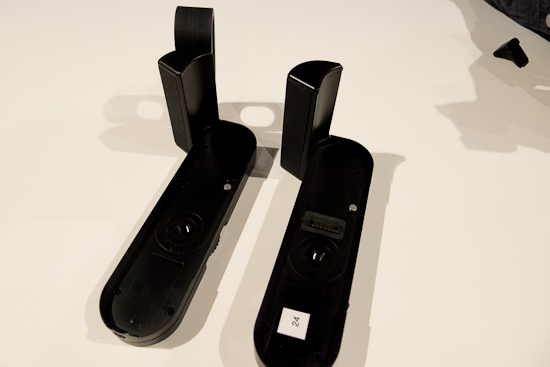
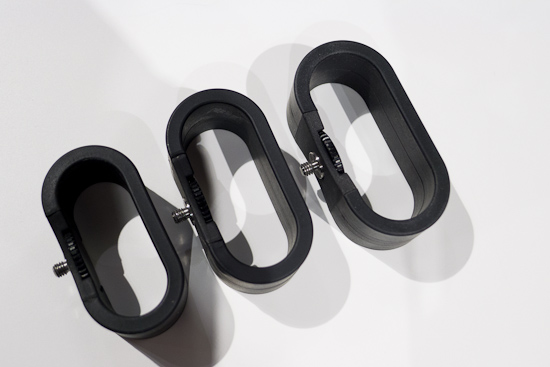
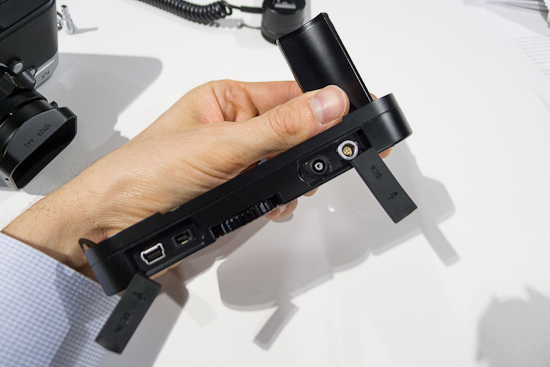
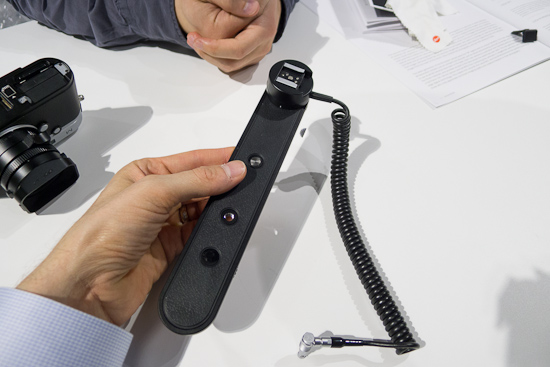
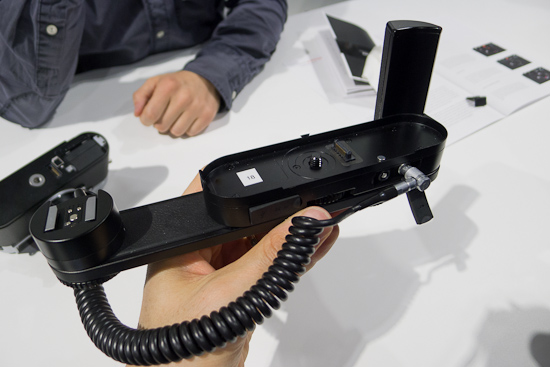
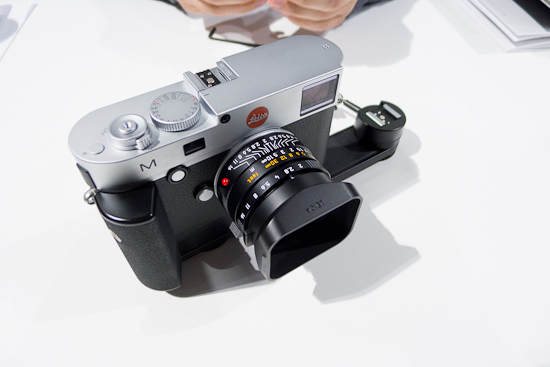
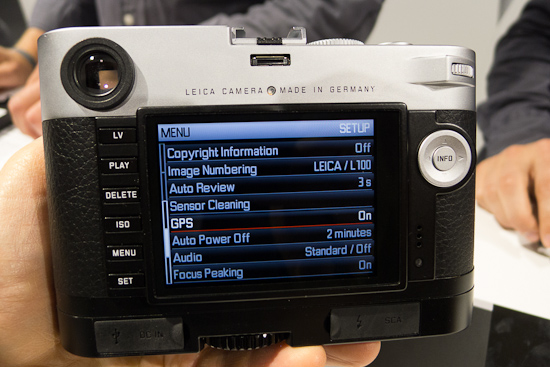
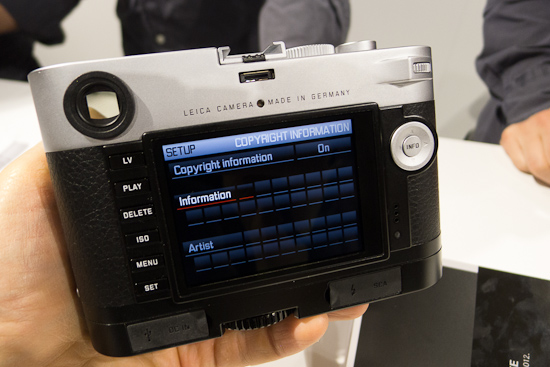
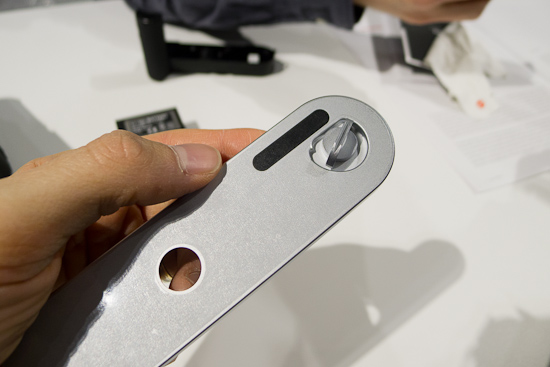
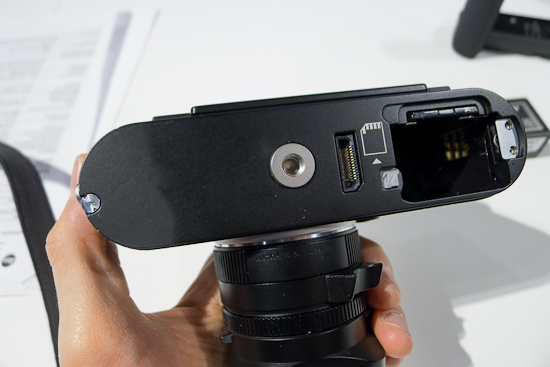
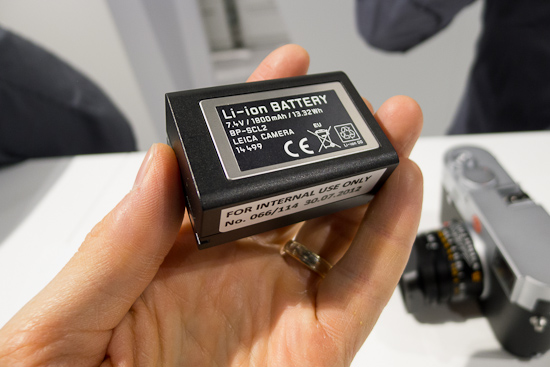
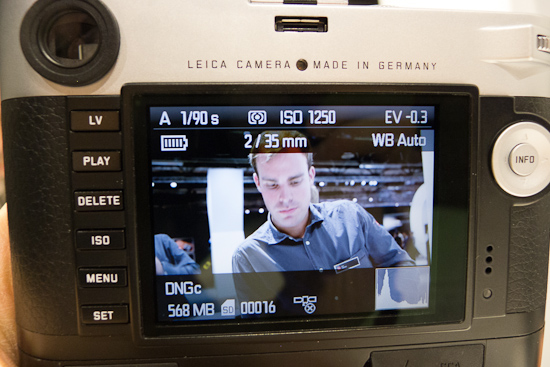
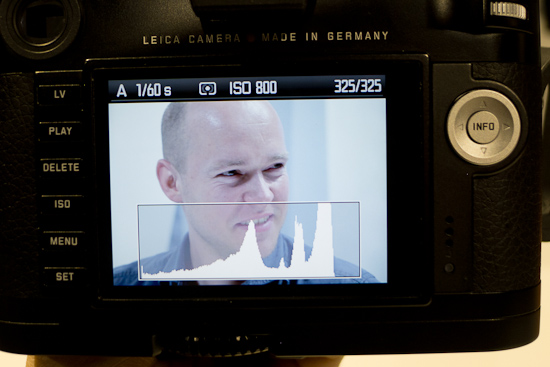
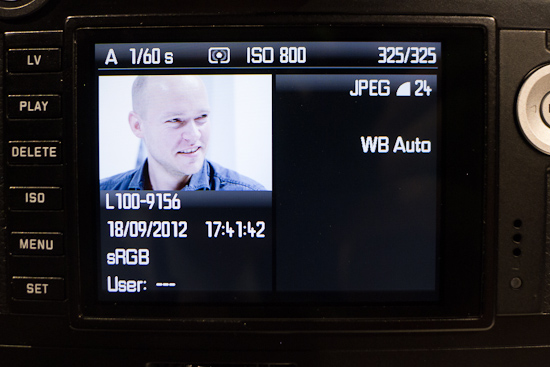
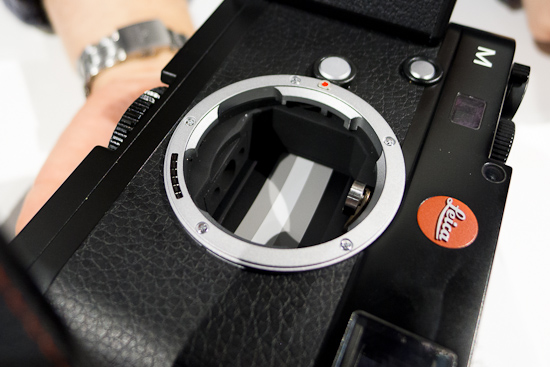
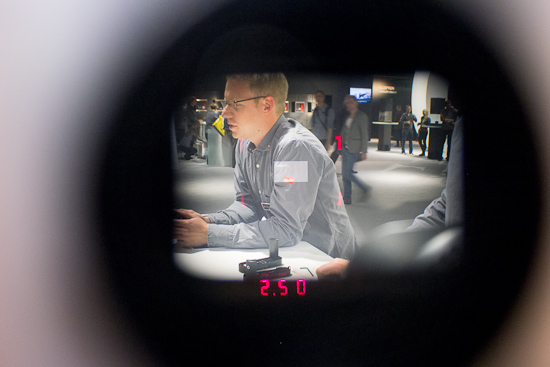
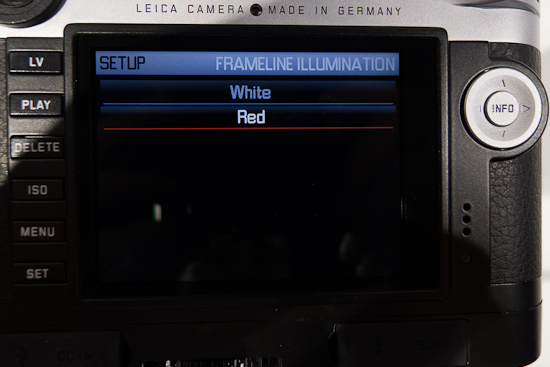
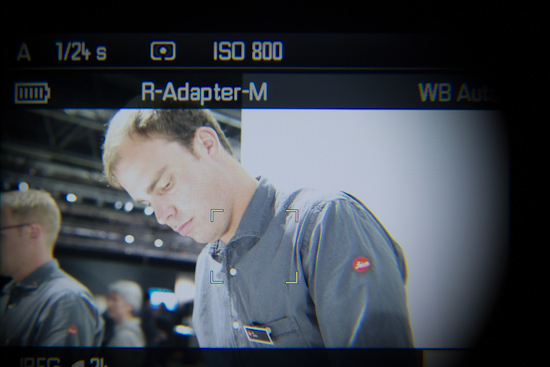
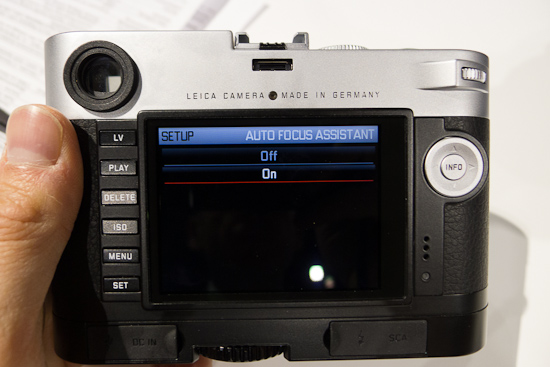
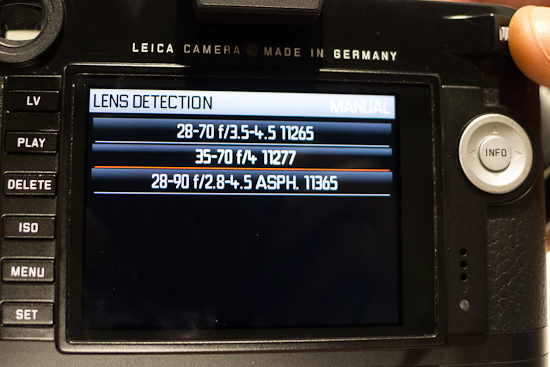
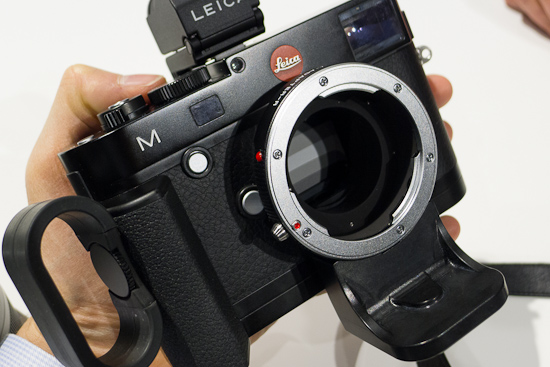
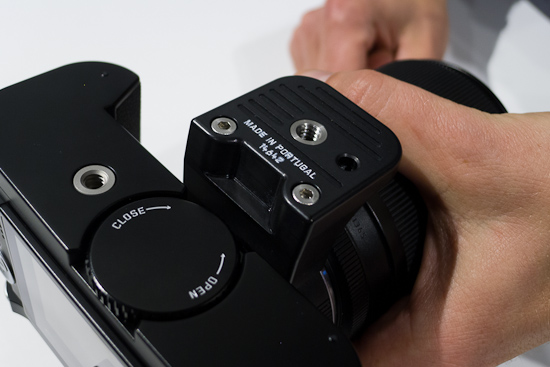
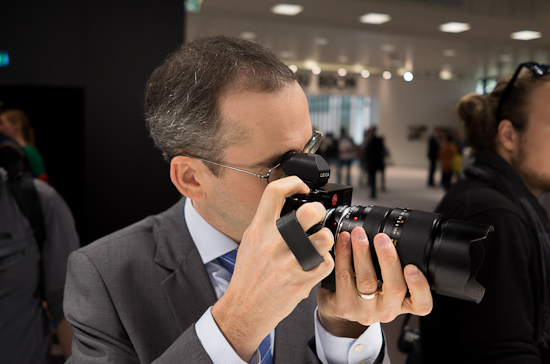
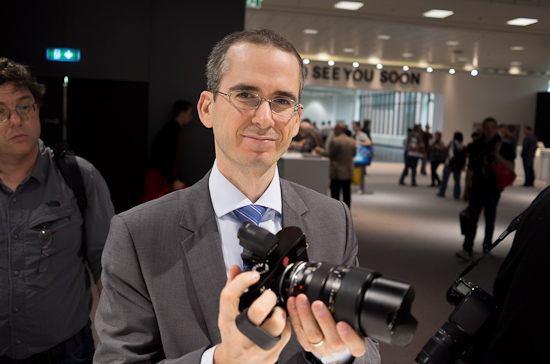
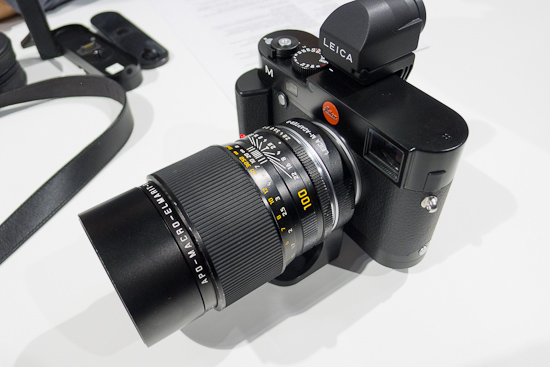
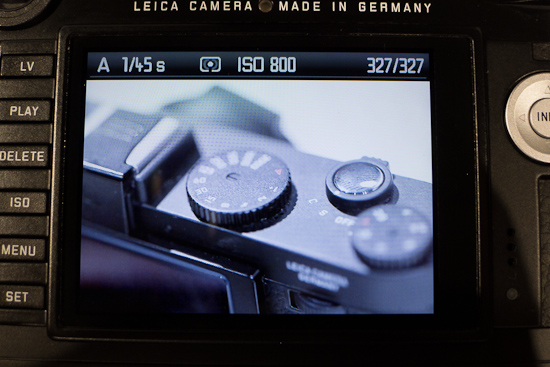
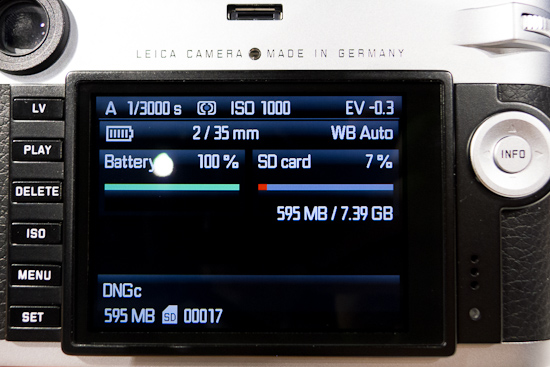
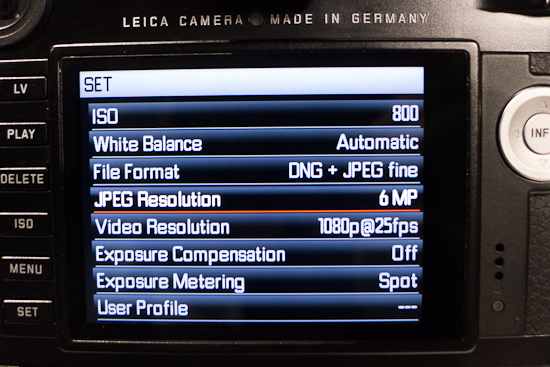
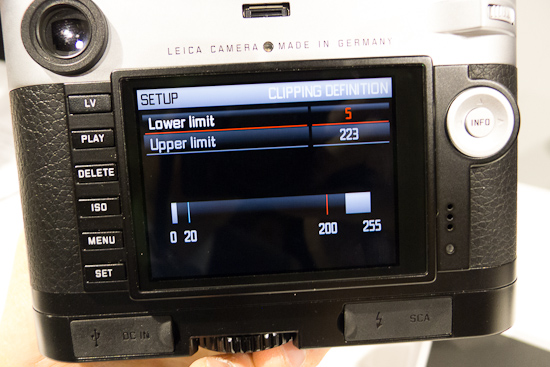
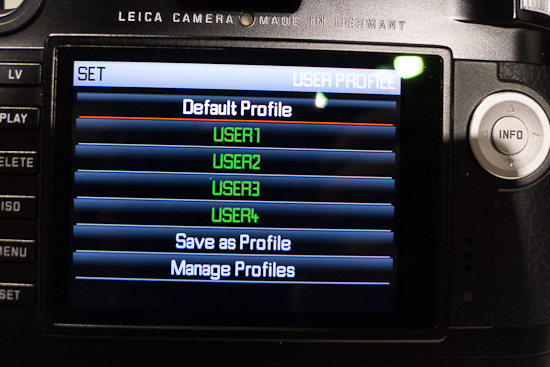
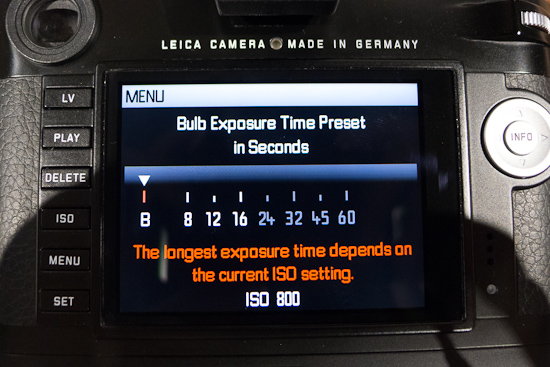
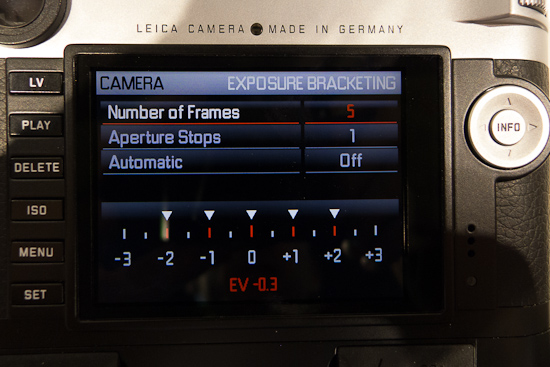
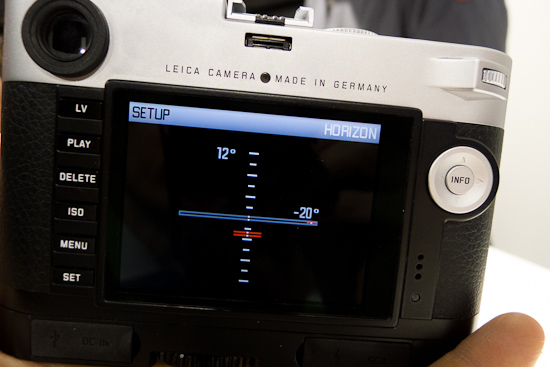
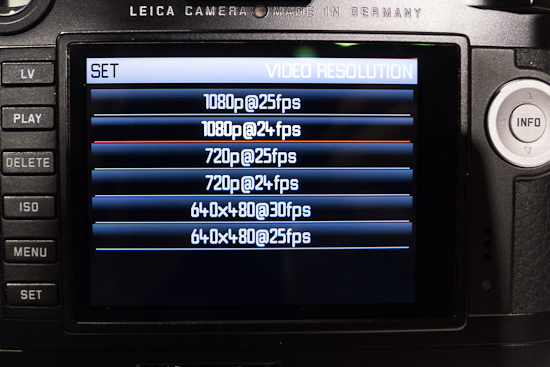
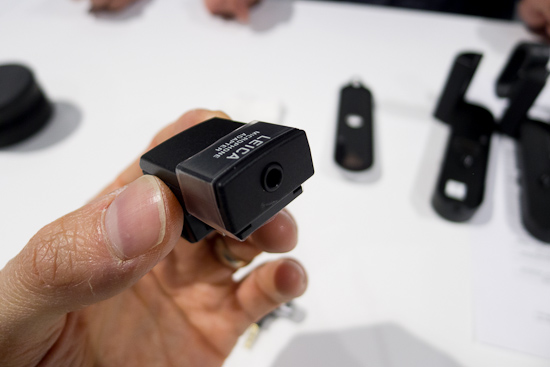
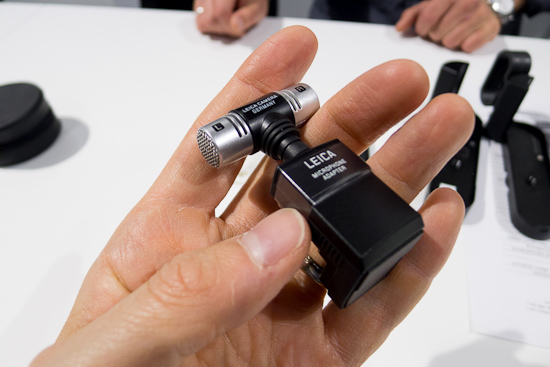
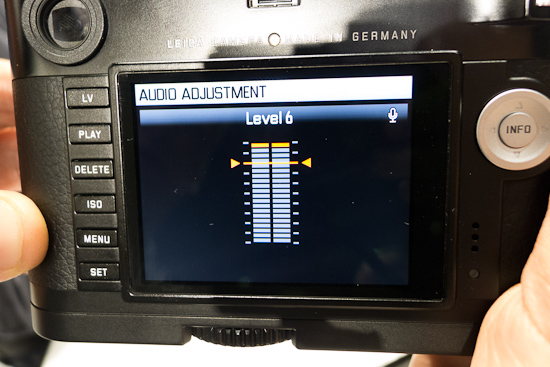
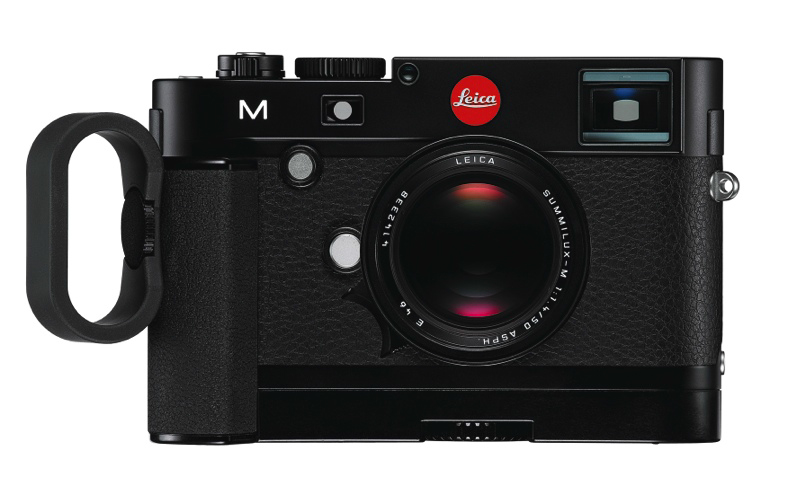



It’s 2024 and I’ve just bought a Leica M8 after borrowing one from a photographer friend (bye bye Lumix). It a silver chrome finished version and I’d like to add a hand grip. Thing is Silver is hard to find and I’m toying with adding a Steel Grey. Will this be a mismatch? Or should I got rad and choose a black one? Thanks in advance
